
guilty pleasures in our collections








An interview with Discworld Emporium by Susanna Mills and Nora Bryson
Micronations and their stamps by Christina Tang-Bernas
17 The Gallery featuring Ilze Brüggemann
by Susanna Mills, Wayne Youngblood, Kathy Johnson, and Matthew Healey
28 Out and About by John Hotchner
26 Make it Stick by Jessica Manack
45 The Feed
StampEd is published quarterly by the American Philatelic Society, Inc., 100 Match Factory Place, Bellefonte, PA 16823.
Opinions expressed in articles in this magazine are those of the writers and are not necessarily endorsed by the society and/or the magazine. StampEd cannot be responsible for the accuracy of any information printed herein.
©2025, The American Philatelic Society, Inc.
EDITOR-IN-CHIEF OF APS PUBLICATIONS
Susanna Mills, 814-933-3803 ext. 207 smills@stamps.org
SENIOR EDITOR Jeff Stage, ext. 221 • jstage@stamps.org
MARKETING MANAGER Nora Bryson, ext. 256 • norab@stamps.org
The movement that created the hobby by Michael L. Wilson
Braille accessibility features on stamps by Christina Tang-Bernas
40 Stamp Trek: Antarctica by Hal Vogel
46 No Bad Questions by Ken Martin and Nora Bryson
48 APS Today by Susanna Mills
GRAPHIC COMMUNICATION SPECIALIST Chad Cowder, ext. 223 • ccowder@stamps.org
ADVERTISING SALES Steve Schwanz Fox Associates, Inc. 800-440-0231 x114 adinfo.theamericanphilatelist@foxrep.com
By Susanna Mills, Editor-in-Chief of APS Publications

Thank you to everyone for supporting the first year of StampEd! When we published our first issue in February 2024, we weren’t sure how this experiment would turn out, but we were driven by a conviction that the philatelic world needed something for the young and the youngat-heart. Our first four issues have been a celebration of art and design, of the online philatelic community, of trying out new things, and of collecting whatever you want, however you want.

In the past year, we’ve received so much encouragement and excitement, both from readers and from our authors. We also received grassroots-level donations from hundreds of people who believe in our mission; these donations will continue to fund year two of StampEd. Looking forward to the second year, there are some changes afoot, based on our experiences this last year. Our current format is a PDF-based online flipbook, designed to look like a traditional 8.5 by 11 magazine, issued quarterly with 50+ pages per issue. What we learned is that most people will not read a magazine cover to cover in this format, and that the 8.5 by 11 sizing is clunky on almost every screen. Plus, the magazine comes out infrequently enough that it is difficult to build an engaged audience.
As I said before, StampEd is an experiment. Why stay tied to a format that isn’t working? In our second year, we are modeling StampEd on other online-only magazines and news sources, with individual articles coming out much more frequently. Other than the format, we’ll be publishing the same kind of articles and columns that you enjoyed in year one, with even more flexibility to try new things.
Keep an eye out at www.stamped.pub for more information on StampEd’s second era.

Send us your ideas and feedback at StampEd@stamps.org.
Contact Fox Associates to place an ad at: adinfo.theamericanphilatelist@foxrep.com or call 800-440-0231 x114

In2004, British fantasy author Sir Terry Pratchett, OBE (1948-2015) published Going Postal, which includes, bar none, the best fictional representation of the invention of postage stamps and the birth of stamp collecting.
The novel is an installment in Pratchett’s series set in Discworld, a fantasy world perched on a flat disc, which in turn is balanced on the backs of four elephants, carried by the Great A’Tuin, a gigantic turtle swimming across the universe. Pratchett published 40 Discworld novels before his death in 2015, and a 41st was published posthumously.
The plot of Going Postal is fairly straightforward (said no fan of Pratchett’s Discworld novels, ever). Con man and forger Moist Von Lipwig is offered a chance to atone for his crimes by starting a new life in government service. His task? Resurrect the Ankh-Morpork Post Office, which has been mouldering for years, sunken under hundreds of thousands of unsent letters. And as if that wasn't enough of a challenge, who needs snail mail when you’ve got the clacks, a network of semaphore towers, to send messages?
“Can you seal [a clacks] with a loving kiss? … A letter is more than just a message.” Moist says. And, can you send a clacks prepaid with a postage stamp?
While it's clear that Pratchett had at least dabbled in the philatelic world prior to writing the novel (he reportedly enjoyed stamp collecting as a child), he was also the consummate researcher. Nearly everything in Going Postal can be tied to a real-world philatelic counterpart, offering continuous delight to the collectors in the audience (Stanley Howler, anyone?).
As Moist brings the Post Office back to life and starts moving the mail, he designs the Disc’s first stamp, the Penny Patrician. He tackles all of the tricky problems that stamp designers in the real world had to deal with, and invents solutions – getting the stamps on the letter (gum), preventing reuse of stamps (cancellations), ease of use (perforations), and payment for more distant locations (new denominations and designs). Soon, the people of Ankh-Morpork are sending letters to themselves, “just so the stamps have been through the post … It proves they’ve been used. That makes them real!”
Meanwhile, Bernard Pearson (Pratchett's artistic collaborator) and Pratchett were collaborating on a special project that would launch at the same time as Going Postal was published – a set of Discworld stamps, just like the ones Ankh-Morpork citizens would buy.
The Post Office halfpenny red, the Penny Patrician, the Morporkia 5p blue and 10p green, the $1 Tower of Art, $5 Brass Bridge, and more (all mentioned and illustrated in the book) became available on July 9, 2004; the first stamps were perforated by Pratchett himself, using a restored Victorian perforator at Bath Postal Museum.
Pearson worked with Pratchett to design Discworld stamps until around 2010, and Ian Mitchell has led the charge since then. Including common issues and intentional errors (known as sports), the team has issued around 1,500 stamps in 20 years. We were glad to speak to both Bernard and Ian about their


letter is more than just a message.
These Discworld stamps fall under the collecting umbrella of “cinderellas,” which are stamp-like in many ways but are not issued by a stamp-issuing entity or valid for postal use. To learn more about cinderellas, see the article on the topic from StampEd issue 3. There are Discworld stamps that are valid for postal use. The Royal Mail issued a set of eight stamps in 2023 in honor of Sir Terry Pratchett and the 40th anniversary of the Discworld series.

The 2023 Royal Mail Discworld stamps feature art by Paul Kidby, whose iconic illustrations have graced the covers of Pratchett’s books for years. The Royal Mail issued several forms, including a collectors sheet with additional labels, and a presentation pack.


Left, the Penny Patrician, one of the first 2004 issues. Based off of the stylings of the world’s first postage stamp, Great Britain’s famous Penny Black (right), the Penny Patrician depicts Lord Vetinari, the tyrant who leads Ankh-Morpork. The Penny Patrician is one of Discworld’s definitive stamps, and is re-released every year with minor design changes.
was the birthplace of Discworld’s first stamps in 2004. In 2011, The Cunning Artificer became Discworld Emporium, which is the official Discworld merchandise headquarters (and branch of the Ankh-Morpork Post Office). Today, Bernard and Isobel have taken a step back from the Emporium and the brick and mortar headquarters is closed, although the Emporium continues its creations online today.
Ian Mitchell. Ian joined the Discworld Emporium crew in 2007 and today is Discworld Emporium’s managing director and product designer.
Susanna Mills (SM): Bernard, you worked closely with Sir Terry on the first Discworld issues in 2004. Can you tell us how the project got started, and about that first set of stamps? Did you expect when you started that you’d still be issuing stamps 20 years later?
Terry Pratchett
experiences and learn how they’ve worked to continue Terry Pratchett’s fantasy legacy.
Bernard Pearson (aka The Cunning Artificer). Bernard and his wife, Isobel, established the first Discworld merchandise shop, The Cunning Artificer, in Wincanton, England, in 2000. They had already collaborated with Pratchett for years, with Bernard sculpting Discworld figurines and architectural models of Discworld landmarks. The Cunning Artificer
Bernard Pearson (BP): I had read the proof copy of Going Postal and thought it would be fun to create a Discworld stamp featuring the Patrician’s head and resembling the old Royal Mail Penny Black. With a bit of Photoshop and the adroit use of a mapping pen, I created something that would, at a glance, look okay. I glued it on an envelope, enclosed a slip of paper with the message “Ha! Ha! Ha!” and sent it to Terry in the post. He didn’t notice the stamp and threw the envelope in the bin! I got a phone call asking me what all the “ha, bloody ha” was about. Terry rescued the envelope from the bin and I was immediately summoned to “Pratchett Towers” and required to bring all the artwork I’d done on the stamp. Terry knew exactly what he wanted and the first set of Ankh-Morpork definitive stamps were created in time for the book’s publication.

The $1 Tower of Art stamp from 2004 is known to have been issued with an “error” – the image of a man falling from the top of the tower.

One recent creative issue was an “error” for an otherwise normal stamp. The common stamp celebrates B.S. “Bloody Stupid” Johnson, an architect and inventor who was known for drawing up plans without unit measurements, sometimes leading to designs that defy the laws of physics. Appropriately, the error version of the stamp is 297 by 420 mm, instead of the typical 37 by 44 mm stamp size. A copy of The American Philatelist is shown for scale.
We never imagined that we would still be issuing Discworld stamps 20 years later, tho’ I knew we’d created something significant when, in 2007, we were asked to send examples for inclusion in the National Collection in the British Library.
SM: The response to the Discworld stamps from Discworld fans has mirrored exactly what Sir Terry wrote about in Going Postal, which in turn mirrors the actual reality of what it’s like to be a stamp collector. Was Sir Terry pleased with this reaction, and to have created this philatelic ouroboros?
BP: Oh yes, very much. My brief from him was “it has to be real, Bernard. Real enough so that if some stamp collector in the future comes across a stamp from ‘Ankh-Morpork’ then that collector will get out an old atlas to find out just where the hell that is.” We were surprised and delighted with the response from the Discworld
fans, many of whom turned out to be serious philatelists or, as Terry called them, “Flatalists.”
SM: How do Discworld stamps go from idea to issue? Can you walk us through the process of designing a year’s issues? Has the process changed much since the first stamps were produced?
Ian Mitchell (IM): I can’t speak for the many and varied artists who have left their mark on Discworld stamps, but these days we have a very regimented and structured system of making-things-up-as-we-go-along, which has been finely tuned over the years to ensure that we always produce precisely what we mean to. Each stamp is different; some come from a desire to make something with a certain look, some come from a concept that we want to shine a light on … Some come from the fact that we’re supposed to have an issue out in 5 days’ time and we have not the foggiest what we’re going to do. Of course, we have to ensure that we keep an interesting mix of designs, and we try very hard to please our different collectors, making sure we have some traditional style stamps mixed in with some slightly more “outthere” stuff. We like to have a good blend of geo-
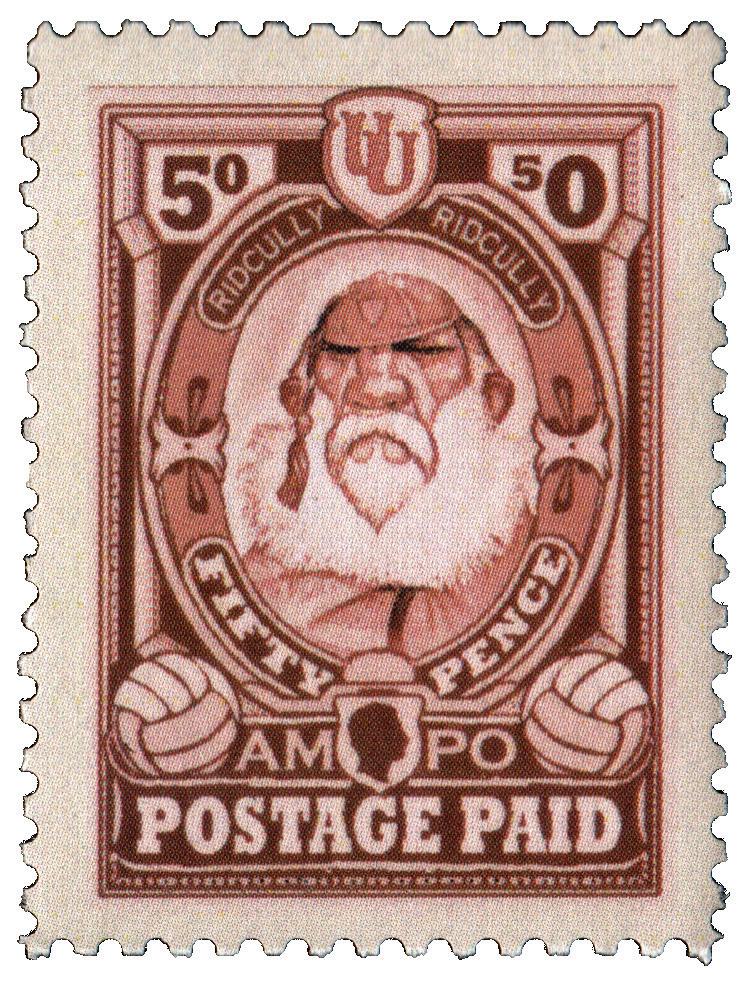
Pratchett’s book Unseen Academicals came out in 2010, about a sports craze that swept through AnkhMorpork for a game very similar to soccer. That same year, Discworld Emporium issued a set of stamps depicting some of the lead players in their football kit.
A Green Cabbage trading stamp, courtesy of Discworld Stamp Catalogue.
graphic regions and cultures of the Discworld represented at any one time.
The biggest change in the designs we produce, of course, came when, sadly, Terry passed. When the world he was creating became… created. Whilst he was writing, we’d often be gifted a little preview from the latest manuscript with an “I think you’ll find there may be a stamp in that” from Terry. Those were always fun. We miss those.
SM: Do all of the stamp designs directly reference something Sir Terry wrote about in the Discworld series, or do any expand on the published canon?
IM: The vast, VAST, majority of the subject matter comes directly from the books, yes … Thankfully, Terry did write rather a lot! Conversely, there’s plenty of wonderful material that he wrote which simply wouldn’t make logical sense to feature on a stamp. We’d LOVE to put Nobby Nobbs on a stamp, purely to see if anyone licked it! [Editor's Note: Nobby Nobbs is a a member of the Ankh-Morpork City Watch, and is probably human, despite all evidence to the contrary.]
Of course, it’s very unlikely that USPS or Royal Mail would feature a local policeman on a postal issue, so we try to keep enough logic to add a sense of realism, but bend the rules enough to make it fun.
SM: Can you tell us about the Little Brown Envelope, which include a mix of recent stamp issues and even rare sports, and Green Cabbage Trading Stamps programs and how they got started?
BP: The “LBE” was Terry’s idea. Both he and Rob Wilkins [Sir Terry’s former personal assistant and business manager, and the current manager of his literary estate] had collected stamps when they were boys and fondly remembered

the bags of foreign stamps they could buy at very little cost and which might contain something rare or interesting. Our LBE became a vehicle for introducing rare stamps and sports into the collector base without anybody having to spend a lot of money. Well, that was the plan!
[With the Green Cabbage Trading Stamps,] in the chase for rare items many collectors were accruing a lot of stamps. A forum was created to enable swaps and trades but even so they did stack up. The ability to return those that were surplus to requirements and cash them in for some rare stamps not otherwise available just seemed like a good idea at the time.
SM: What is your favorite stamp issue, and which issue that you worked on were you most excited for the public to get their hands on?
The Green Cabbage Trading Stamp program started when the Emporium realized that many collectors were ending up with too many extra copies of each stamp. In 2005, it introduced a trading scheme, in which collectors could send in their extra common stamps back to the Emporium and receive, credit in the form of Green Cabbage stamps in return. Once a collector has a certain number of Green Cabbage stamps, they can trade those in for a rare or special edition item. For a history of Green Cabbage trading stamps through 2015, see the Stanley Howler Stamp Journal: www.stanleyhowlerjournal.co.uk


This 2018 issue was issued as a series of 12 stamps, each with an encouraging slogan for reformed vampires. The perforations would be understandably difficult to produce. Courtesy of Discworld Stamp Catalogue.
IM: Personally, it has to be the coffin-shaped stamp which formed a coffin-shaped sheet to commemorate the work of the Uberwald League of Temprence (vampires who have sworn off the “B-vurd”). I’ve never heard our perforating pixie, Steve, swear quite so much, and with such passion.
SM: A recent edition of the Discworld Emporium newsletter announced that you’ve stepped back from monthly releases, in part to be able to focus on designs that really excite you all. Can you share anything about upcoming projects that spark that excitement for you?
The Unseen University is a school of wizardry, invented by Pratchett in his first Discworld novel, The Colour of Magic (1983). This 1 penny UU issue from 2021 is one of many UU stamp issues honoring that most august institution.


All orders from the Discworld Emporium come with Discworld stamps on the envelope and an in-universe receipt. One of the first I ever received was purportedly from the Ankh-Morpork Thieves Guild, which is a legal professional guild for thieves.
IM: For a long time, I’ve wanted to produce an acceptance letter that might rival those of other Schools of Wizardry … Unseen University made its way to the page decades before some of these magical upstarts! In general, I think we’re all quite excited about bringing a bit more narrative back into the range.
SM: Receiving a package from the Discworld Emporium feels like actually receiving a package from the Disc, thanks to the stickers, stamps, and ephemera included. Even email correspondence includes little references to the Disc, like code from Hex, the Unseen University computer. How did these special (delightful) touches get started, and why is
The 2009 Alchemists Penny Farthing raises money for the Guild of Alchemists’ Widows and Orphans Fund, very similar to a real-world semipostal (which are sold with an additional surcharge which is then donated to a charitable cause).
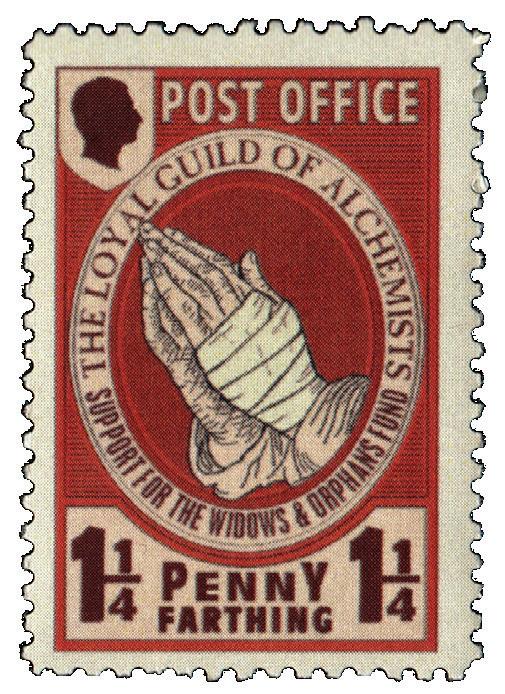
it important to the Emporium to continue them?
BP: A bit of serendipity. Once we’d established the Green Cabbage trading arrangement the stamps started to roll in. The drawers filled up and filing cabinets overflowed. You couldn’t use them to roll a cigarette and they were no good for stuffing cushions. So, we started sticking them on anything. Ian, the cat, and then of course the outgoing mail.
We continue because it’s a way of telling the story. Keeping the fun on the outside as well as the inside of our mail.
SM: Many of the early Discworld stamp designs are direct references to famous real-world stamps –the Penny Patrician [in the style of the Penny Black]; the Brass Bridge [similar to the iconic Cape of Good Hope 4-penny blue triangle issues] – while others reference lesserknown aspects of philately, like the charity/semipostal stamps. Do you have philatelists on-call when designing the issues?
IM: If there’s one thing we have learnt about philatelists during our forays into the postal world is that you don’t have to call them, they will call you. And they will provide you with all the delicious tidbits of knowledge that they have gleaned over the years… whether you like it or not.
SM: One of the philatelically exciting aspects of the Discworld stamps is the inclusion of sports, purposeful “errors” that are highly collectible. Have there ever been
In Discworld philately, most issues have two design types, “Common,” and “Sport.” Sports are intentional design errors by the design team. Sports can either be found on the full stamp sheets, or sometimes appear only in the Little Brown Envelopes. Like real errors, sports are harder to find, especially as single stamps. Imperfections and varieties do exist as well, of course. The most common are color variations or misprints that can arise naturally in the printing of any stamp. Scans of known examples are included in the Discworld Stamp Catalogue.
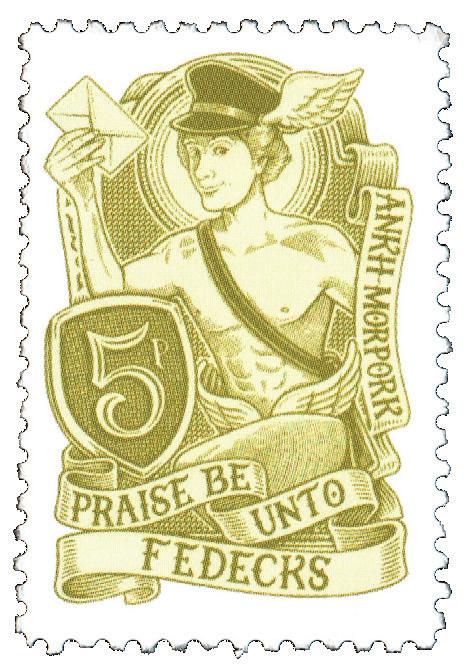
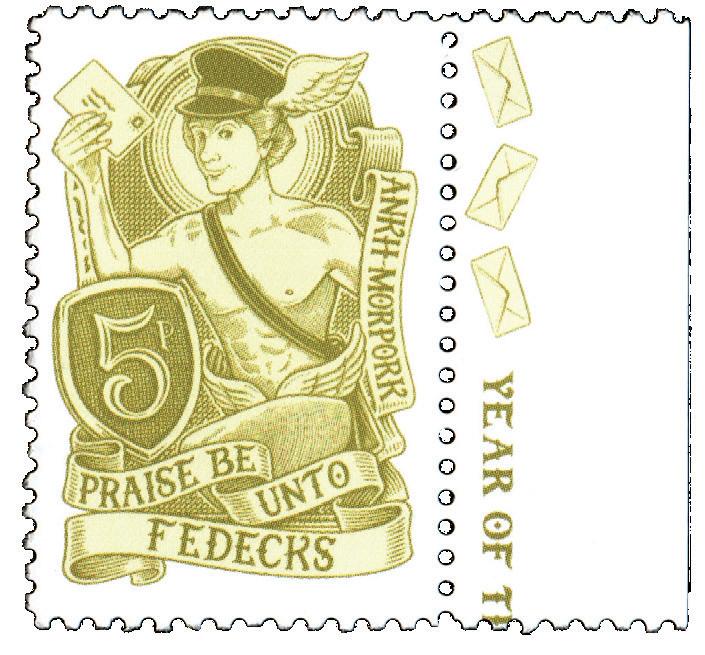
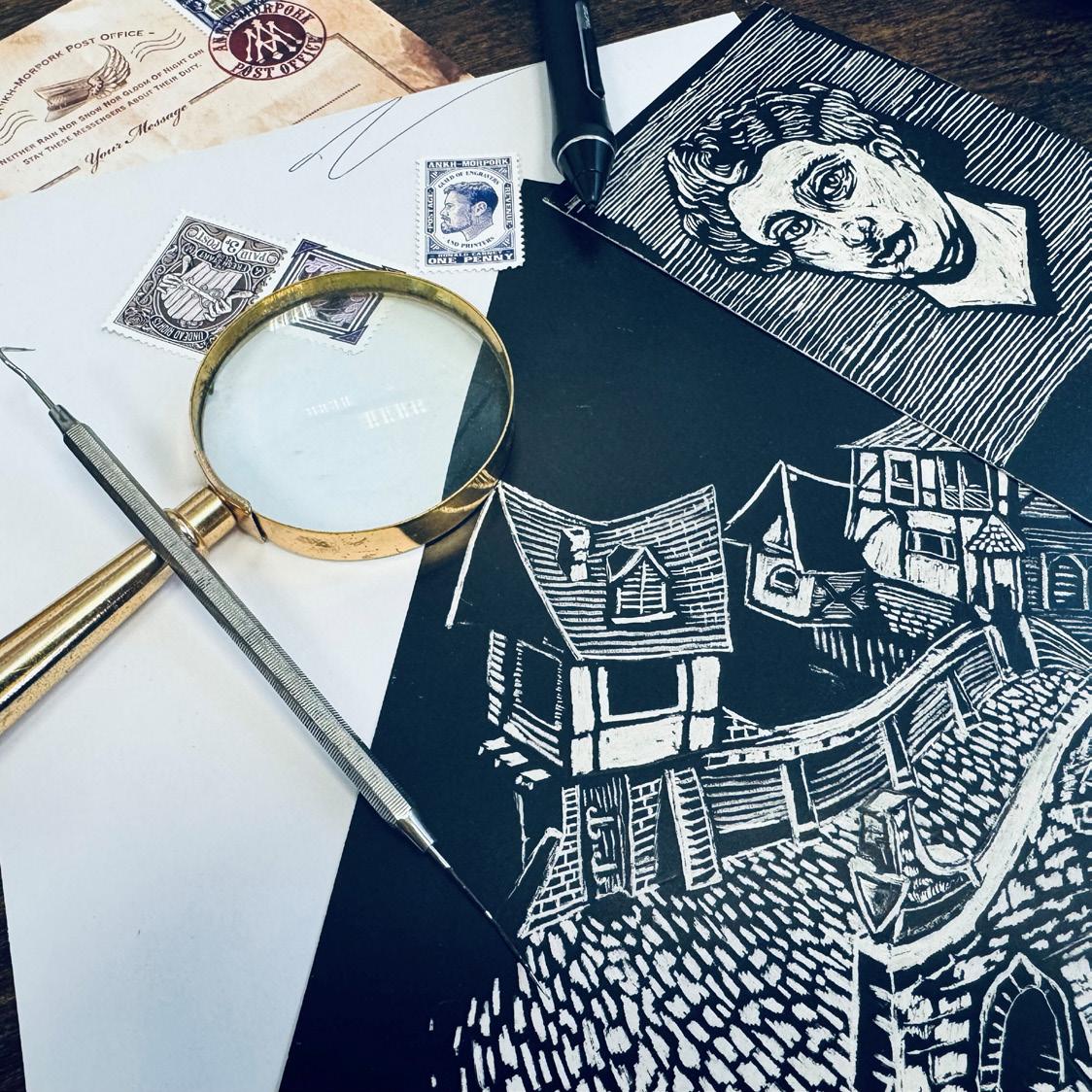
any true errors released that you know of?
IM: No. Absolutely not. We’ve never made a mistake ever. Nope. No… maybe.
SM: Are the stamps still totally designed and produced in house, or do you have your own Teemer and Spools (the in-universe printer of stamps in Ankh-Morpork) to assist?
IM: We still design the vast majority here in-house. Of course, we’ve had a lot of guest artists over the years, who prefer to work at their-house… but the printing has almost always been handled by our trusty “Mr. Spools,” Terry W. He’s a true expert with decades of experience in all manner of print. Though it still tickles me that he has to drape bits of tinsel from his big posh printer in order to caress the static off of our stamp paper as it passes through!

The Discworld Stamp Catalogue, found at www.discworldstampcatalogue.co.uk, is maintained by Steve James. It has extensive information about all Discworld issues, ephemera, and even fan-produced stamps.
SM: A frequent reference for collectors of Discworld stamps is the Discworld Stamp Catalogue website, as well as the collecting forums. As a stamp collector, it’s amazing to see the detail and time fans put into cataloging these cinderellas – do you contribute to that knowledge base at all, or is it entirely fan-driven?
IM: The stamp catalogue is entirely down to the hard work and dedication of our collectors. Steve James, the curator of this marvelous work, is one of a kind. He has become our firm friend over the years, and we cannot thank him (and his contributors) for their efforts. In fact, I think it’s high time we recognize him in an official issue.
Thank you again to Ian and Bernard for answering our intrusive questions. As someone
who is, in essence, competing with other Discworld collectors to add the earlier issues to her collection, I realize that this article may hurt my ability to do so by adding more collectors to the field. However, I am also a diehard Discworld evangelist and believe that Going Postal is an excellent place to get into the series, if you’ve never encountered Sir Terry’s books before.
Thank you to Ian Mitchell, Bernard Pearson, the Pratchett Estate, and the team at Discworld Emporium for their assistance with this article and for safeguarding our beloved Disc. Thank you also to the Discworld Stamp Catalogue.
If you are a fan of Terry Pratchett’s, a lover of cinderella stamps, or just enjoyed this interview, check out Discworld Emporium (https://www.discworldemporium.com) and the latest stamp issues. If you want to begin your Discworld stamp collecting journey, you can begin with the new issues and Little Brown Envelopes. I have found individual stamps and whole year collections offered on eBay (although if you are US-based, as I am, you may have better luck with www. eBay.co.uk, as the Discworld books had a much more impressive foothold and fanbase in the UK than in the US). Your journey to build your Discworld collection, like mine, will be a longterm one, and that’s what makes it fun!

By Christina Tang-Bernas
Norton Day – sponsored by the micronation of Molossia as the first international holiday exclusively for micronations – is celebrated on January 8 each year in observance of the death date of Emperor Joshua Abraham Norton I, the self-declared Emperor of the United States and Protector of Mexico (Figure 1).
During his reign – from his declaration on September 17, 1859, to his death in 1880 – Emperor Norton would make proclamations dressed in an elaborate blue uniform, inspect the neighborhood institutions, and even issue money in the form of bills accepted by local stores in San Francisco.
The idea that someone could create their own government without bloodshed or interference with the overarching government around it is something that resonates with people around the world, leading them to form their own micronations.
According to Britannica, a micronation is an “entity that claims to be an independent state but whose sovereignty is not recognized by the international community.” They are formed for many reasons, ranging in levels of seriousness, with many of them issuing their own passports, currency, and, of course, postage stamps.
The stamps of micronations are considered cinderellas because they are not accepted as postage by the Universal Postal Union (UPU) and are often only valid within each micronation. In fact, many micronations emphasize on their websites that these stamps should be used in conjunction with, rather than instead of, accepted postage. So, why create them at all? Let’s find out from those who know!
Originally established in 1977 and currently led by President Kevin Baugh, Molossia is located in three different enclaves within the states of California and Nevada for a total area of 11.3 acres.

Molossia is one of the more prolific issuers of its own stamps (Figure 2), producing over 80 since its founding. Baugh said in an email interview that he believes that “stamps can show off aspects of a nation’s and micronation’s culture, and perhaps enhance awareness of nations to each other.”
This is part of his goal to strive “to unite small nations, and to extend the world of small nations into the world of large nations.” To him, it’s only natural for Molossia to produce its own stamps, since “all nations produce their own stamps for their postal service, and Molossia is no different. … In addition, many small nations, such as Andorra and San Marino, sell stamps as a part of their economy, and Molossia does as well.”
As in the postage stamps from larger nations, the subjects of micronational stamps often depict the nations’ leaders and flags as well as the important anniversaries and holidays marked by each individual nation (Figure 3). Many micronations also issue stamps reflecting historical and current events going on in the outside world.
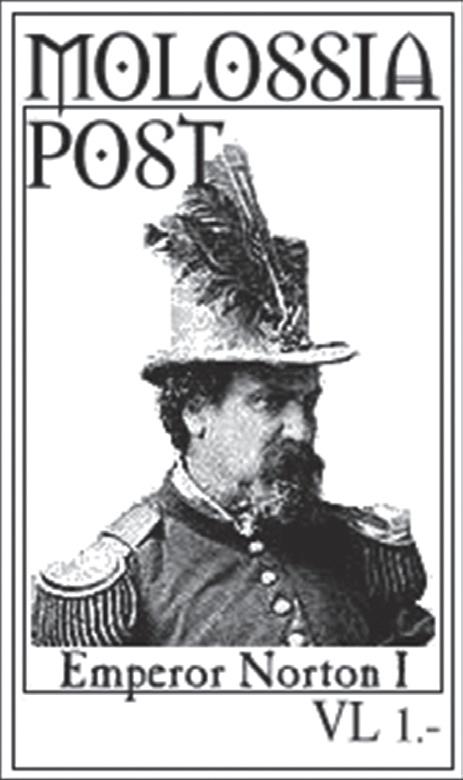
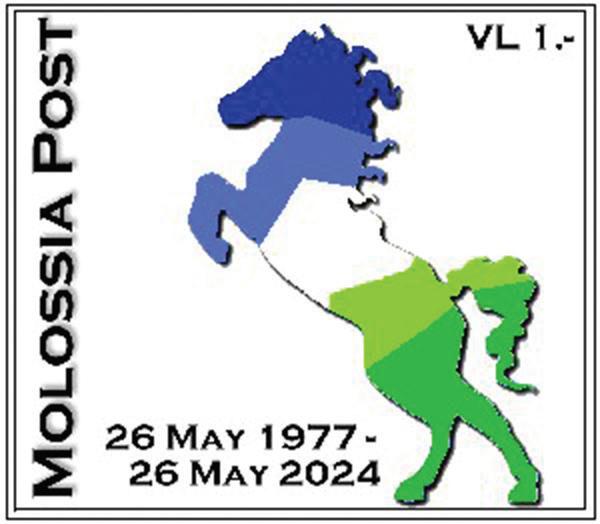
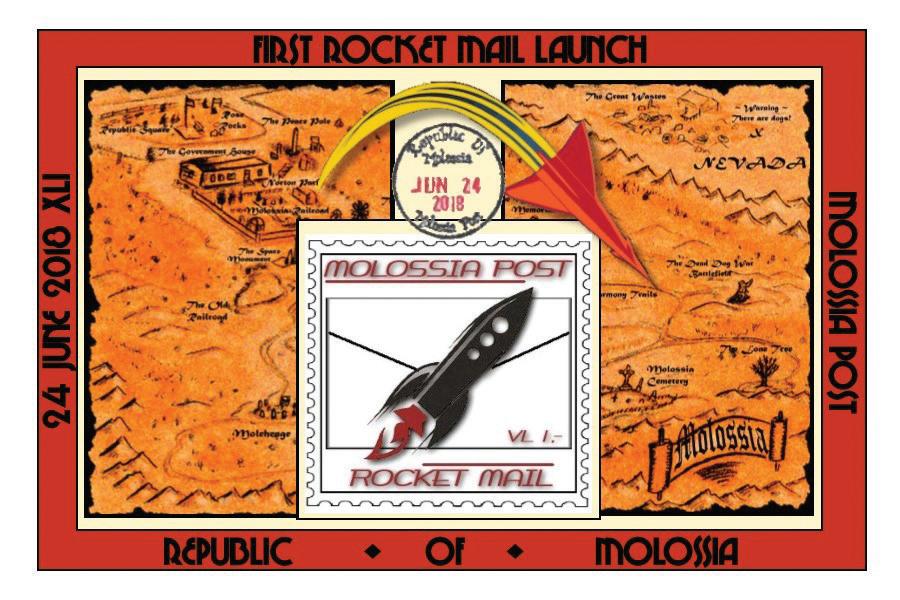

Beyond that, it’s not surprising that it’s often the founders and leaders of these micronations that decide on the designs. For Molossian stamps, Baugh says, “I decide on what stamps will be issued, and it’s completely by whim. For example, I have a liking for post-impressionist paintings, so we recently issued a series of stamps showing off some of my favorites (Figure 4). A few years ago, I was very much into silent movies, and thus we issued a series of stamps showcasing silent movie stars.”
While only moderately successful, Molossia even experimented with a rocket mail delivery system. On June 24, 2018, the Molossia Postal, Telephone, and Telegraph Service launched a small hobby rocket containing mail into the sky (Figure 5), according to the Molossian website. The P-1 postal rocket was launched several times and delivered mail each time within Molossia. The experiment has, sadly, not been repeated.
The collection of rocket mail is part of a specialized branch of philately called astrophilately. In the 1920s and ‘30s, aviation technology was developing quickly. There was a lively competitive spirit across the world to invent things that would advance mankind’s ability to fly and even reach outer space. With these developments, use of rockets to deliver mail was seen as an inevitability, once the technology was there. One famous example was the first and only missile mail mission by U.S. Navy submarine USS Barbero in 1959. Barbero fired a Regulus cruise missile with commemorative covers aboard to the Naval Auxiliary Air Station in Florida. While there have been many successful postal deliveries via rocket across the decades, the cost, compared to regular airmail service, has made its implementation just a dream of the early aviators.

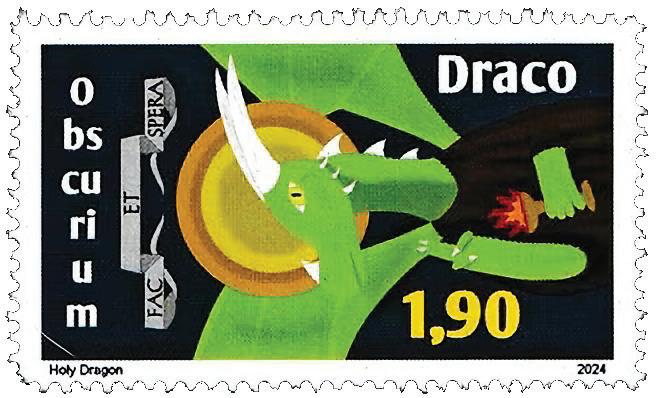

Obscurium President Zar Antonov calls the micronation “a land so obscure, you’ve never heard of it.”
Located within northern Germany, Obscurium was first introduced to the concept of creating postage stamps at an intermicronational event. Not long afterward, Obscurium issued its first stamps to celebrate its fifth anniversary, in March of 2023. The micronation continued to issue stamps afterward as a window into the nation, Antonov said in an email interview this past fall.
“The idea is that if you look at our stamps, you can understand a bit of the history of Obscurium, its ideas, culture, values, and its intermicronational friendships,” he said. Obscurium’s national symbols are dragons, so many of the stamps are dragon-focused (Figure 6).
However, it’s important to Antonov that Obscurium isn’t a nation where his is the only voice heard, so he often incorporates art from other Obscurian citizens, including the winner of an art contest (Figure 7). These designs are specifically made to be featured on stamps, with pre-existing motifs and subjects chosen by Antonov and the designers he works with.
Antonov taps into the wider micronation community as well. Obscurium has issued multiple joint stamp issues with other micronations in the spirit of cooperation and friendship between these microna-
If you want to make your own stamps, Juergen Schwarz says not to worry about technical perfection; even some well-known stamps use very basic design techniques. His recommendations for the main considerations a designer should focus on are to make sure the text is more than 2 millimeters (larger for the country name and stamp value), to use a maximum of two different fonts, and to have high contrast in the image components, as well as the text against the image.
Stamps for micronations actually make up only a part of YourStamps’ customer base, with small-batch orders also coming from artists as well as local or island postal services.
The typical production process starts with either a finished design or a base image with requested design considerations and text that Schwarz helps the client create into a finished design.
This finished design is loaded into the printing software, and a PDF “preprint” proof is sent to the customer for approval. Once approved, the stamps are printed onto gummed paper – paper that already has water-activated glue on one side – with a laser printer. It is then perforated by either the line perforation or fixed format perforation machines.
After being cut to size with a guillotine cutter, the stamps are ready to be sent to the customer. Schwarz's years of experience and experimentation have enabled him to create almost any type of sheet layout, only limited by the properties of his perforation machines.
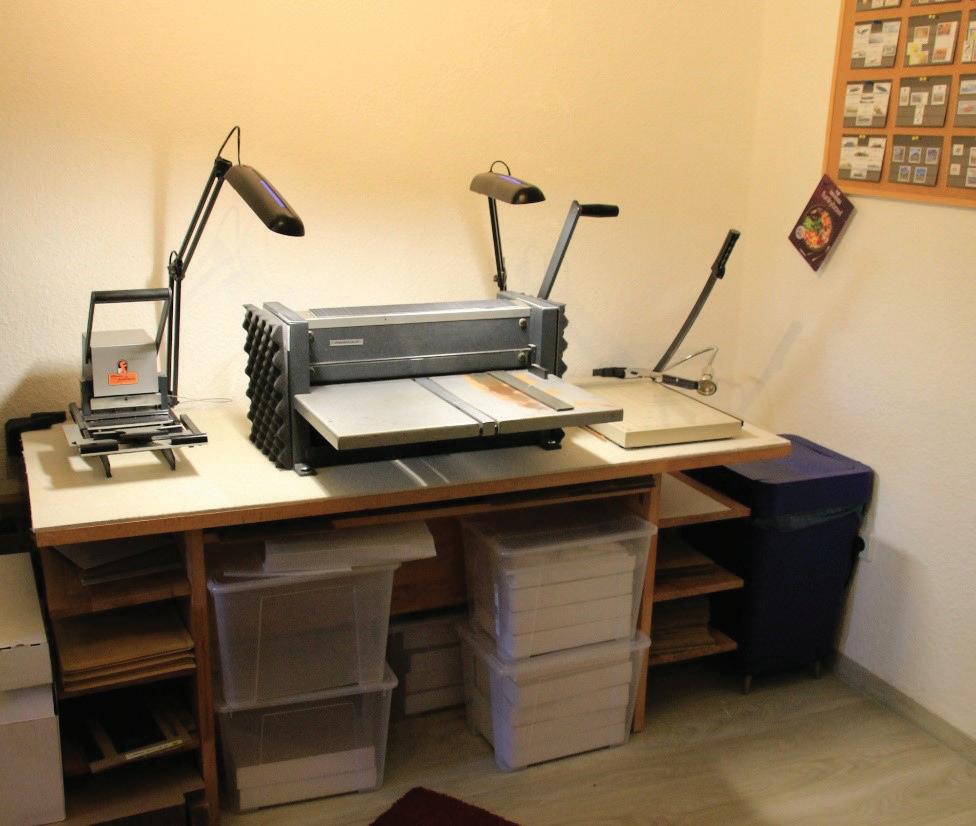



tions, as well as to celebrate intermicronational events such as the Digi Micro Summits and Micro Euro Summits (Figure 8).
For Juergen Schwarz, postmaster general for Posta tal Musograd of the Federated Micronations of Musania, his love of postage stamps grew in tandem with the development of his micronation. As a stamp collector from childhood, he combined this love of stamps with his burgeoning political interests by inventing a nation.
With the purchase of his first computer in 1985, Schwarz began designing stamps (Figure 9) that documented the historical development of this nation, telling a story of a “compressed variant of real-world history” over the years, which carried “hidden allusions to the layers below it.”
In fact, in a nod to stamps used to depict history from the point of view of the state, he created multiple stamps that depict a certain incident that took place in this alternate history – the disastrous “Shoolscath” operation – but in which the “official” views of this incident changed, depending on the respective governments controlling Musograd at the time (Figure 10).
After acquiring a perforation machine by chance in 2003, he started a business printing small-batch stamps, YourStamps, based in Berlin, Germany. The stamps he designed then became a combination of “personal/micronational history and sample stamps production” for his business.
Being a longtime stamp collector, the aesthetics of Musogradian stamps are often influenced by the typical designs of “real world” postal services (Figure 11).
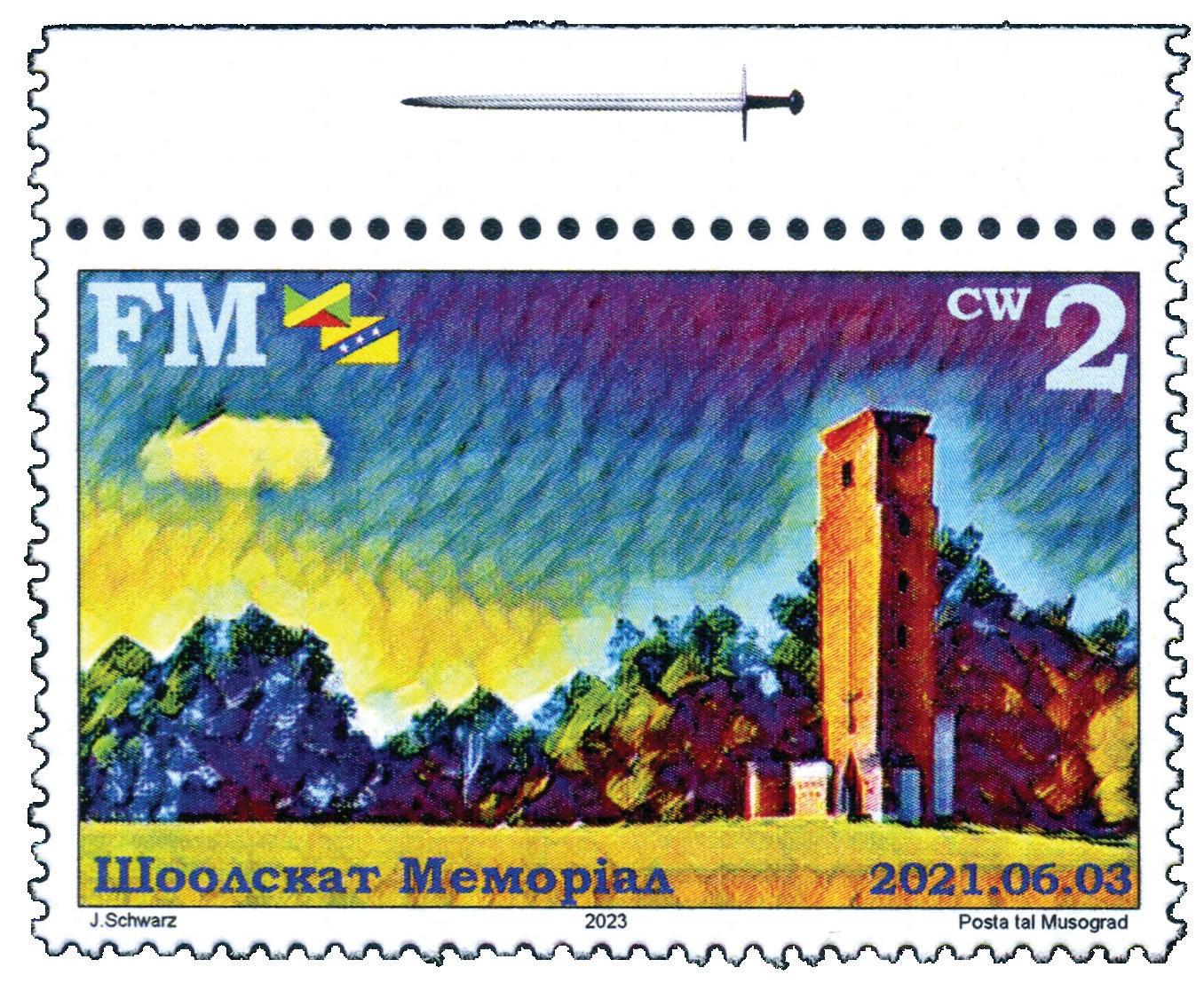

Schwarz also has an interest in classical music, science, and science fiction (Figure 12), and keeps a list of important anniversaries for these topics, for future stamp issues. Schwarz uses art received from friends and family, as well. However, the art he receives is generally not made specifically for stamps, so Schwarz will match designs to a particular stamp issue and create the stamp based on the design.
Due to the more flexible nature of micronation formation and dissolution, it can be difficult for an interested collector to keep track of existing micronations, much less which are issuing stamps and at what frequency. While some micronations, such as Obscurium, do document their stamp issues and release their own catalogs, it’s Ralph Phillips who has taken on the task of putting together a catalog of all micronation stamps.
Phillips said in a recent email interview that he was first inspired by his own long-time stamp collection. At the age of 50, he realized that he had an estimated 250,000 stamps, and decided to focus his collecting to British Isles locals. Since this “gray area” of collecting didn’t have a dedicated catalog, he created his own, which was well-received and led to him creating catalogs for United States and Canada locals as well. Then, he turned his sights on micronational stamps, scouring websites for information and compiling now almost four CDs worth of material.
Phillips believes it's unlikely that micronational stamps will rise in value the same way that official postage stamps can, but says there will always be a market for micronational stamps. That's provided, of course, that the subjects of the stamps continue to align with the interests of collectors — particularly topical and thematic

Figure 12. A commemorative for the 150th anniversary of Jules Verne’s 20,000 Leagues under the Seas, 2024, for Balanda, designed by Ariane Wulf, Posta tal Musograd. (Courtesy of Juergen Schwarz).
collectors — and that the stamps are issued in reasonable amounts.
Schwarz adds that collecting and creating micronational stamps is a great extension of “conventional” philately and a growing interest among collectors. While there is a risk of artificial “rarity,” this is “an area of collection where one should never strive for completeness,” Schwarz said.
One organization promoting and protecting the interests of micronation stamps in the global stamp market is the micronation equivalent of the UPU, the Micronation Postal Association (MPA) (Figure 13).
The MPA states it is “the primary forum for cooperation between postal services of micronations” as well as “an advisory organization that provides technical assistance where needed to micronations in establishing and maintaining a postal system.”
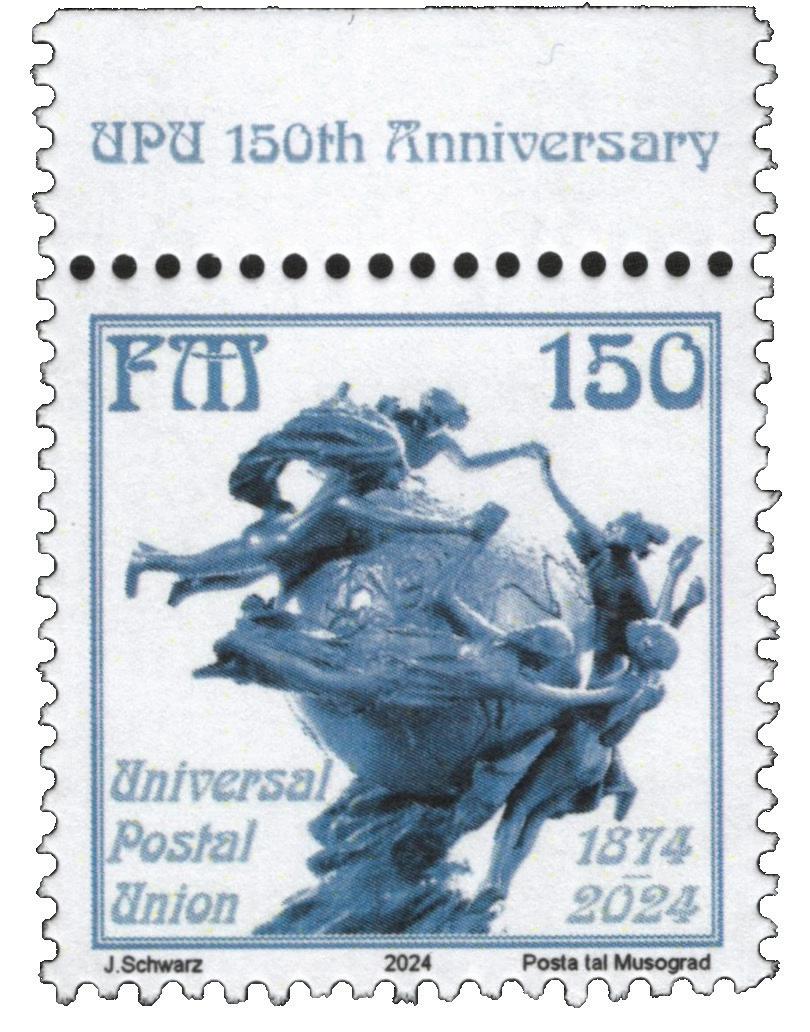
Figure 13. Commemorative issue
“Universal Postal Union – 150th Anniversary,” 2024, designed by Juergen Schwarz, Posta tal Musograd (Courtesy of Juergen Schwarz).
The headquarters of the MPA is in the micronation of the Republic of West Who, which is located on 0.35 acres within Denver, Colorado and boasts a national museum, a space agency, and the world’s smallest spy agency for its 620 citizens from around the world. The MPA is responsible for facilitating crossborder postal services and provides guidance to its 35 member nations for international mail. According to John Farr, the minister of citizens affairs for West Who, these members honor each other’s stamps for delivery between micronations, though they are still reliant “on the nation state the micronation is surrounded by to actually deliver their letters.”
Therefore, micronations often stick their own stamps on mailed envelopes in addition to official postage stamps. For letters outside Molossia or West Who territory, a U.S. postage stamp is placed alongside their own stamps. Schwarz puts Posta tal Musograd stamps on the left side of the envelope, with the top right still reserved for postally valid German stamps, and has never had a problem with the German postal service, except when he forgets to cancel his own stamps.
After discussions with the Australia Post, the Hutt River micronation puts its stamps only on the reverse side of outgoing letters. Antonov was even able
to mail letters from the Czech Republic and Liechtenstein using only self-canceled Obscurian stamps, though the same didn’t work in Germany.
Looking at an envelope decorated with both micronational stamps and those of larger nations leads to the question: What changes an item that is essentially a sticker into an official postage stamp?
Answer: Recognition under international law and the UPU, which “guards the use of stamps as manifestations of sovereignty.”
Therefore, “are stamps a presentation of sovereignty, an effort to bolster claims to sovereignty, or a critique of the whole concept of sovereignty? At times, stamps are all three,” according to a 2023 article in the London Review of International Law. Scholars “have long recognized the role the postage stamp plays in reflecting and constructing national narratives and identity,” the article said. When micronations “design, issue and use their own postage stamps, they visibly harness the symbolism and trappings of statehood that stamps carry” to mark their existence, saying, “We are here.”
Antonov, Zar. “Dragon Mail Official Stamp Catalogue, 2023-2024,” https://aps.buzz/DragonMailCatalogue “Emperor Norton I,” Microwiki, https://micronations.wiki/wiki/Emperor_Norton_I.
“How to Start Your Own Micronation,” The Official Website of the Republic of Molossia, https://www. molossia.org/howto.html.
Hobbs, Harry and Jessie Hohmann. “The Cinderella Stamps and Philatelic Practices of Micronations: The Materiality Of Claims To Statehood,” London Review of International Law (2023). Micronation Postal Association. Accessed December 13, 2024. https://micronation-postal-association.webnode.page/
Obscurium. Accessed December 15, 2024. https://obscurium-gov.wixsite.com/main Schwarz, Juergen. “Microphilately: Micronations and their stamps,” presentation for Posta tal Musograd, https://www.posta.musograd.org/Microphilately_20220618.pdf.
Stamp Catalogues, YourStamps. Accessed December 15, 2024. https://www.yourstamps.eu/catalogues.html.
“Rocket Mail,” the Republic of Molossia. Accessed December 7, 2024. https://www.molossia.org/postal4.html YourStamps. https://www.yourstamps.eu/.


Last year, freelance writer and translator Ilze Brüggemann published a book, Map Cards for Africa, that expressed her love for her home of South Africa and the surrounding nations through her hobbies of philately and deltiology. Using stamps, postcards, and objects symbolizing important elements of her own life and history, Ilze creates collaged scenes that bring the locations she highlights to life. Photos of those scenes then become map cards of their own, and travel the world via Postcrossing exchanges.
On how she chooses what to include in a collage.
The card chooses, if not dictates, the elements required for it to become a meaningful item. Take, for example, Kimberley. This mining town is known for its diamonds, so diamantés need appear there. The same applies to Johannesburg, where gold was very important a few centuries ago. Gold calls for golden beads … the other items on other cards are required so that each province obtains the unique feel that separates it from the rest – might I add that most of the cards start with the stamp.
When you understand what the stamp is meant to represent, you can add the other elements.
Clearly, I’ve been collaging for many years, and to me, it’s important that you not only “feel” the texture of the different elements, but also recognize its semantics.
On
some of her favorite images from creating her book.
I created the collage [below] to display Map Cards for Africa at a stamp exhibition held in July 2024. The beads are a central feature of the postcards related to Cape Town and as for the cap, it belonged to my great-great-grandfather when he attended school in Stellenbosch. The black-and-white image is of Jan van Riebeeck, the founder of our country; the coins on that page are genuine coins used in South Africa in the past. The indigo beaded necklace that appears in the book was made by my gardener, and the beads on my hand are a type of Zulu beaded glove. The rest of the items are genuine postcards from my stock.
The collage [page 19, above] was created at the same event, except that this one relates to the postcards of the Cape Peninsula. I’ve owned Great Danes and absolutely love them! It goes without saying that my thematic stamps were ideal to accompany this page in the
book. Simon’s Town has a little statue of the Great Dane known as Just Nuisance (as seen on the postcards).
On the story behind her favorite map card.
I also collect stamps of writers, especially poets. Lieutenant-Colonel John A. McCrae (also a physician) fought during World War I. The extract of the poem quoted on the stamp on the postcard (as seen on page 19, below) was written on May 3, 1915 (May 3 is also my birthday), a month after a battle fought at Belgium’s Ypres Salient, where McCrae lost a good friend of his.
All these snippets of information led me to a map of Belgium with questions such as, “Where is Ypres?” and “What is the significance of Passchendaele/Flanders?” Once I had my finger on that, I could finally understand why the people in the UK could hear the bombs falling across the waters and I could make sense of the images written about in A Broken World, Only Remembered, Shell Shock, and In the Corner of a Foreign Field, to name but a few of the books I’ve read on the topic.
The poppy comes from a local war veteran who sold it to me on Armistice Day, which creates a link with this famous poem. The other three Belgian stamps were ones that I had amongst my swaps. One of them looks like a war scene, and one of the others was the oldest I


could lay my hands on at the time. Just imagine the significance of a Belgian stamp franked in 1915 on that card!
On her favorite stamps.
I would have to point you to the 10¢ Pietermaritzburg City Hall stamp [South Africa Scott 577]. At one stage, I thought I’d never tire of placing this stamp on a map of KwaZulu-Natal simply because I used to work up the road from there at Shuter & Shooter Publishers when it was still based in Church Street. On extremely stressful days I’d walk down the street, past the City Hall to the Public Library situated right behind it. There would be no need for me to take a book out, I just needed to sit between the shelves and be aware of the silence of the books surrounding me to calm down and face the stress in the office again.
Opposite the City Hall is the Tatham Art Gallery, which had a lovely little
coffee shop you could go to at lunchtime and not worry that you’d be late for your afternoon shift because it was all within walking distance. As a child, I attended concerts in the hall, from Gé Korsten in "The Student Prince" to the German singer Heino, to the philharmonic orchestra … and so this little piece of paper represents volumes of memories for me.
On her advice for those picking up philately and deltiology as hobbies.
My advice to anyone interested in this hobby, be it deltiology or philately, is to keep sending items via the mail. Make use of Postcrossing (or The Handwritten Letter Society; or try PostSecret) and send, send, send! If people start treating the postal service as a white elephant, then that is what it will become, and so our hobby will shrivel up and die. As collectors we shouldn’t be shy to talk about what we do – collect mini encyclopedias – and why we find it important.


I’ve been spending the last few months struggling to get into The Count of Monte Cristo I’ve never read it before, but it’s one of those books that you feel like you should read, if you’re a serious kind of person – like War and Peace, or James Joyce's Ulysses
In that same time period I’ve torn through five or six… well, let’s call them “trashy” romance novels. Fun to read, but I’m not going to go boasting to my friends about them like I’ve read a world-renowned classic.
So maybe trashy romance novels are my guilty pleasure. On the other hand, isn’t artistic snobbery a bit silly? People will enjoy what they enjoy!
This all applies to stamps and philately, of course. You may run into philatelic snobs who think you aren’t a proper collector unless you can lengthily pontificate on the minute differences between a U.S. Scott catalog 25 and a 25A. But the truth is that any collector collector will have items that are just for the fun of it.
That’s why we asked a handful of collectors to tell us about the guilty pleasures in their collections. Philately’s not so serious – sometimes it’s funny, stupid, trashy, offensive, poorly made, low-art fun.
– Susanna Mills, Editor-in-Chief
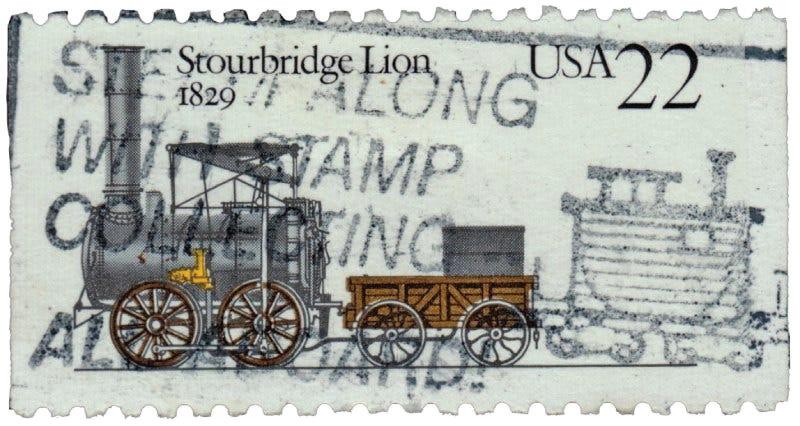
The placement of the caboose from the National Stamp Collecting Month postmark couldn’t have been more perfect, hooking it up to the back of the Stourbridge Lion locomotive. This cancel is not only humorous, but appropriate to the subject.
By Wayne L. Youngblood
I suspect most of us have multiple collecting areas, some far more serious than others. And, in most cases, it’s probably difficult to ascertain when, why or how we became interested in any given area – but we are, and we continue to maintain some of these collections.
As I’ve frequently noted, the incongruous and humorous juxtaposition of stamp and cancel is an unusual — if not rare — occurrence in normal mail handling. Hundreds of millions of pieces of stamped mail pass through U.S. canceling equipment each month, virtually all receiving “normal treatment” (that being either a smudgy digital cancel or none at all). Still, some gems, such as the ones shown nearby, turn up and many older ones lie undetected in accumulations.
In my case, I can directly trace the genesis of one of my fun obsessions – dealing with what I consider to be either humorous or appropriate cancels on stamps – to a frustrating and misguided incident.
As long as I can remember, I’ve been fascinated by fancy cancels. Of course, as a young collector I couldn’t afford to collect them, but other types of cancels intrigued me, and I frequently pulled them from the mixtures I regularly sorted and soaked.
In an effort to be more efficient, I once ordered a 20-pound mixture of stamps from Great Britain and decided that I should dump most of them in the bathtub and process a large batch, rather than soaking smaller batches in bowls. Without going into great detail about this particular failed experiment and the resulting mass of paper pulp that used to be stamps, one of the ruined stamps featured a pictorial cancel depicting a profile of a dog. The dog’s face was exactly the same size as the queen’s on a Machin stamp, giving her an entirely different – and rather funny – long face. I searched in vain for years to replace that particular rarity.
However, that incident made me look at stamps entirely differently from then on, with an eye always towards finding
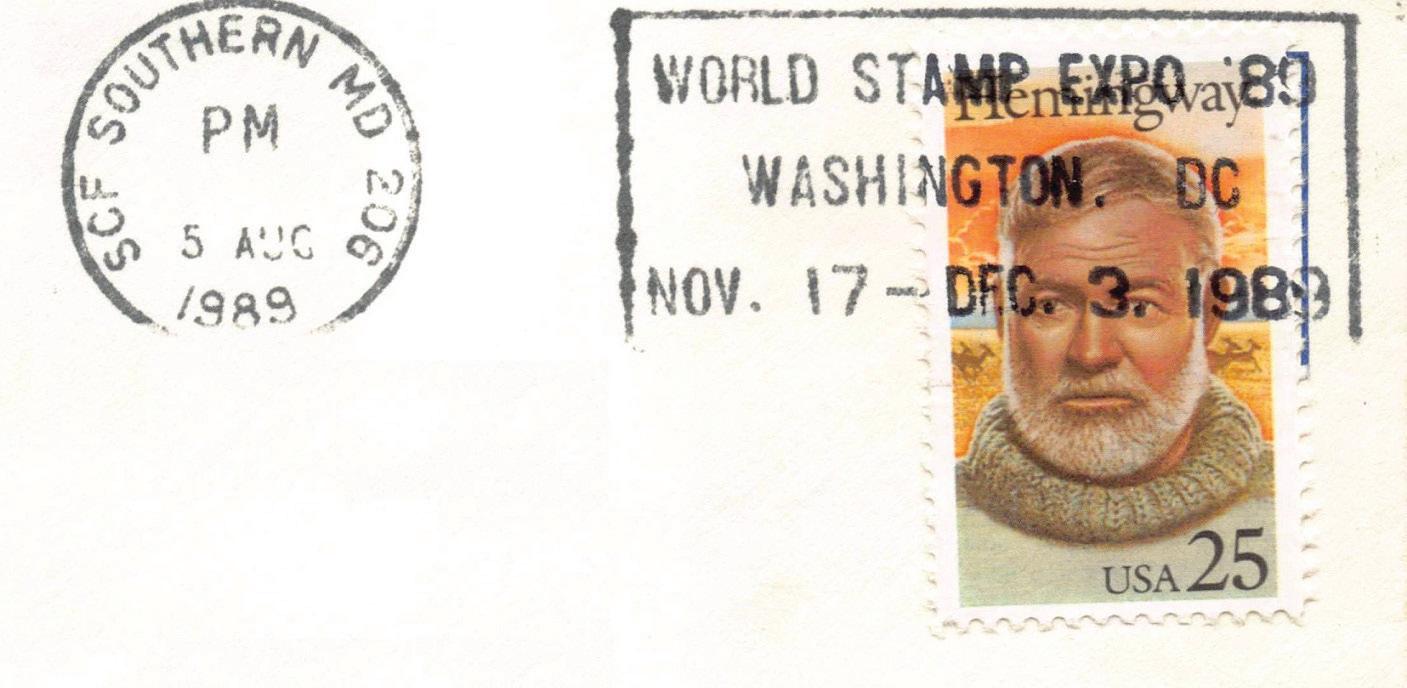
[My] fervent search helped maintain a healthy interest in stamp collecting during times when my interest was high, but resources were extremely limited.

The humorous interaction of the “Loose dogs will bite” cancellation with the subjects of these stamps is clearly apparent.
stamps with cancels that I felt were either funny or appropriate, based on their placement and interaction with the stamp design.
Over the years this obsession has resulted in two different tongue-in-cheek exhibits, as well as numerous articles and presentations given to stamp clubs. But, more importantly, this fervent search helped maintain a healthy interest in stamp collecting during times when my interest was high, but resources were extremely limited (as a boy, beginning a career and as a young parent). The excitement with which I added new items to this collection was as great as discovering a new error. These true rarities may not have cash value, but they are a treasured part of my collection.
By Kathy Johnson
Victorian Ceylon philately has always been my thing, the beautiful line engraved classic Victorian issues – beautiful! Fantastic postal history, lots to study, fun to exhibit. Along the way as I collected Ceylon, I also started picking up early postcards from Ceylon, especially if they advertised the island’s glory: its tea, its gems, the pearls.
Ceylon, now Sri Lanka, is a lush tropical paradise by the shore, with dense jungle highlands at its core. In the jungle: Elephants! I started collecting elephants on Ceylon postcards and that led to my very narrow niche (and politically incorrect) collection of elephants going down waterslides.
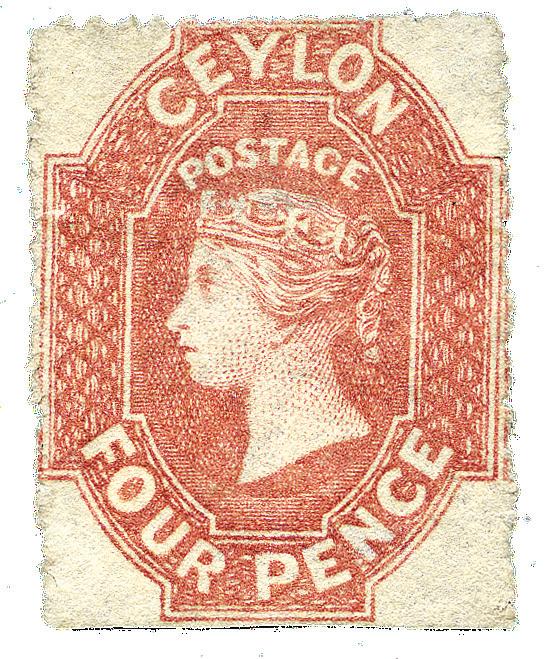
The first decade of Ceylon issues saw three main designs, with multiple denominations and shades. This is Ceylon Scott 27, issued in 1861.
This card is my favorite, a promotional postcard from the “Franco-British Exhibition 1908.” Yes, they sent elephants down those slides as a tourist attraction.

Elephants love playing in water, but do they enjoy a waterslide?
By Matthew Healey
As a typical Gen Xer, my collecting has often been casual and focused on fun, rather than having any rigorous methodology. In high school, nerd that I was, I assembled a few pages of “dead countries” to exhibit in my high school library — places like Danzig, Trieste and the Canal Zone.
When I dived back into the hobby as an adult, I eventually got a little more focused, but the funloving part of me never stopped making “little collections” of things I found serendipitous or amusing. Some of these may one day evolve into single-frame displays, but most of them will sit in a binder on my shelf, purely for my own enjoyment.
One, which I’m happy to share here, began when I found this common British definitive stamp of the late 1960s, with Arnold Machin’s timeless portrait of Queen Elizabeth II and a denomination of 5 pence (expressed as “5d” in the old notation). At the time, it paid the basic first-class domestic rate in the United Kingdom.
What caught my eye was the place name in the cancellation: Blackburn, Lancashire. (Actually, it’s “Blackburn & Accrington, Lancs” but the Accrington is partly obscured by the dark blue design of the stamp.)
As anyone who’s spent any time listening to the Beatles can attest, the sound of the words “Blackburn, Lancashire” immediately summons an earworm of the famous closing track from Sgt. Pepper’s Lonely Hearts Club Band, “A Day in the Life”:
I read the news today, oh boy, Four thousand holes in Blackburn, Lancashire
Well, that did it. I had to save that one. Still, it was a solitary treasure, with no thought yet given to it becoming a collection – even a collection of one.
Then the next stamp showed up. Another postmark with a Beatles connection:
Oh, dirty Maggie May, they have taken her away
And she won’t go walk down Lime Street any more…
The fun-loving part of me never stopped making “little collections” of things I found serendipitous or amusing.


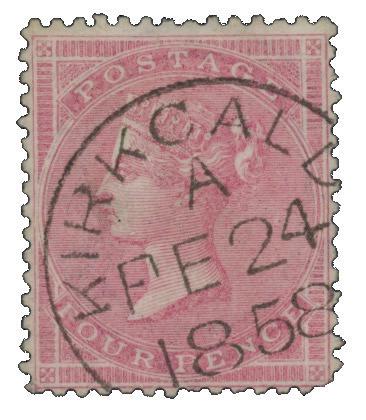
Four-pence rose stamps in this design were issued in the late 1850s. This usage in Kirkcaldy was in 1858.

That one is a traditional folk tune, covered by the Fab Four on their final album, Let It Be. Lime Street is near the waterfront in their hometown of Liverpool, and while it was once something of a red-light district, it also had a telegraph office in the 19th century, which is when this Victorian 1-shilling stamp was used there.
Soon enough, I came across another Victorian beauty. This one references a deeper cut than casual fans may be accustomed to hearing: The Duchess of Kirkcaldy, always smiling
And arriving late for tea
That lyric is from “Cry Baby Cry,” a track on side 4 of the 1968 double album The Beatles, generally referred to as “the White Album.” The lyrics are nonsensical — Kirkcaldy is a real place in Scotland, though it never had a duchess. But never mind. Three, as they say, is a trend, so I now had the basis of a collection. I set about scouring Beatles lyrics for further place names.
The early specific geographic location referenced in a Beatles song is Kansas City, the title of a Little Richard song (originally penned by Lieber and Stoller) they covered in 1964. It wasn’t until their later years that Lennon and McCartney started referring to specific places in their own songs, though.
Another track from Sgt. Pepper, “When I’m Sixty-Four,” mentions the Isle of Wight:
Every summer we can rent a cottage
In the Isle of Wight, if it’s not too dear
This was the first stamp in my Beatles place names collection that I went looking for, as opposed to having it turn up by chance. It wasn’t too challenging: the Isle of Wight is a fairly big place, and as a popular summer holiday destination, there was plenty of mail sent from there over the years.


The mother lode for name-checking places in a Beatles lyric was, of course, “The Ballad of John and Yoko,” issued as a single in the U.K. and on “Hey Jude”, the album of leftovers issued in the U.S. after the band split up in 1970.
There are six or seven places mentioned here, from the dock at Southampton to Vienna to the Amsterdam Hilton. That latter one is tricky to find on a philatelic item; I had to content myself with an old picture postcard showing the hotel. But Gibraltar, where John and Yoko got married in a hurry, obligingly issued a whole set in 1999 marking the 30th anniversary of the occasion, including this souvenir sheet.
Peter Brown called to say, ‘You can make it okay,
You can get married in Gibraltar near Spain ...’
So there you have it. My guilty collecting pleasure. Fits on a single album page!
What are your guilty pleasures in your stamp collection? Let us know at
or
By Susanna Mills
I was lucky enough to stumble upon a big cache of these cancellations at a free-sort table of stamps at Great American Stamp Show a few years ago. The cancellation pictures Shrek and Donkey, and although none of them included the full text, it also reads “Greetings From Far Far Away” to the left.
Obviously I’m a Shrek fan – at first ironically, but as most people know if you spend enough time liking something ironically, you eventually find yourself really, actually liking it. Shrek (2001) is a DreamWorks animated movie and an influential installment in the now-popular genre of deconstructed and parodied fairy tales. Shrek 2 (2004) may be even better than the first movie, featuring as it does the now-iconic Fairy Godmother’s “Holding Out For A Hero” cover of the Bonnie Tyler original.
Mass popularity of the Shrek movies aside, this struck me as an unusual partnership for the USPS.
It turns out that it’s not unusual for the USPS to design special cancellations marking cultural moments. Technically, a special cancellation is authorized by the USPS only for a national purpose “for which Congress has made an appropriation,” (think of this like a public service announcement), or for matters of general public interest and importance. The Shrek cancellation (we have to assume) is the latter. Commercial tie-ins like this one aren’t unheard of (a similar example might be the Rudolph the Red-Nosed Reindeer postmark used during the 2014-2015 holiday season, depicting Rudolph as seen in the 1964 movie and the text “Happy Holidays”).
The partnership with DreamWorks had a dual purpose: first, to promote the release of Shrek 2 on May 19, 2004; second, to use the cancellations and the movie tie-in to encourage participation with National Card and Letter Writing Month in April.
The 2004 National Card and Letter Writing Month theme was “send mail they’ll treasure.” The USPS prepared a publicity kit for the occasion, encouraging such local activities as have
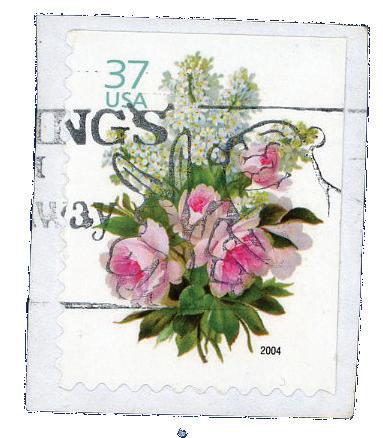


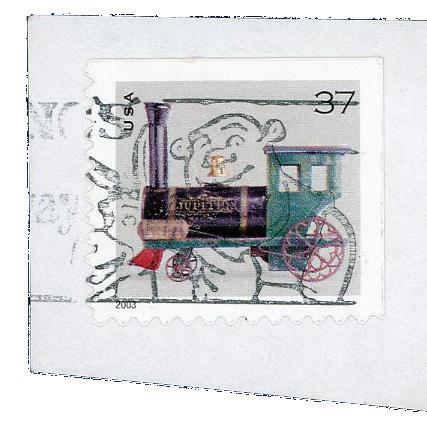
The USPS authorized the use of special Shrek 2 cancellations between April and June 2004, in partnership with DreamWorks and in advance of the movie’s release.
elementary students “write a letter of thanks to Shrek and Donkey.”
I think what I like the most about these cancellations is that they’re just a little bit ridiculous and unexpected, and that’s what makes them fun. You could see this as a crass commercialized ploy by the USPS to get kids interested in stamps and sending mail – and yes, it probably was, and surely the effect was minimal. But I don’t mind it. I like seeing evidence that the USPS tried something interesting, and I like when we don’t take ourselves too seriously.

An intact example of the Shrek 2 cancellation, reading “Greetings from Far Far Away.” Courtesy of “Half Done Something of the Week.”
It’s hard to express the cultural impact Shrek has had, especially in online-based millennial and Gen Z communities. Much of the impact is in shared humor, memes, and references, and of course, there’s a whole generation who only know the Monkees’ “I’m a Believer” due to Shrek’s Smash Mouth cover. On the other hand, like any online community, it’s not all family friendly jokes. Actually, I’m going to explicitly tell you not to go too deep searching for Shrek, lest you find something exceptionally disturbing.

By Jessica Manack


Wax seals have been a way to ensure the security of a mailpiece for thousands of years, with examples of a similar system found as far back as Mesopotamia and Ancient Egypt. The wax, soft when warmed, and dripped over an envelope’s sealed seam, breaks upon opening, immediately showing whether the confidentiality of a dispatch has been breached. This decidedly low-tech method worked for a long time, though was not tamperproof. Seals could be re-warmed and re-applied, if an interceptor was motivated enough.
It’s worth noting that wax seals were just one type of method used to ensure the security of a mailpiece’s contents. Letterlocking is another technique, dating back to the 13th century, which employs intricate folds that can be opened only once without tearing, providing concrete evidence of tampering.
Today, when secure communications are more likely to be sent digitally, or through official services such as registered mail, sealing letters with wax is more of a design concern than a functional one. And there are many ways to explore using them in your mail.
First, you’ll need to source your supplies – which is easier than you might think. Wax stamps in a huge variety of designs can be found, ready-made or custom-designed – with designs ranging from monograms to designs showing a special aspect of your personality, like your zodiac symbol or something related to the place where you live.
There are lots of options for melting wax, too – you can hold a taper over your mailpiece and let it drip, use a tea light (with or without a special holder to hold a spoonful of wax pellets), or use an electric wax warmer, which, because it avoids open flames, is a great choice for children. It’s simple to leave a quick setup on your desk that can be used and put away in just a few minutes.
Choosing the wax itself might be the most fun part. Online merchants offer wide variet-
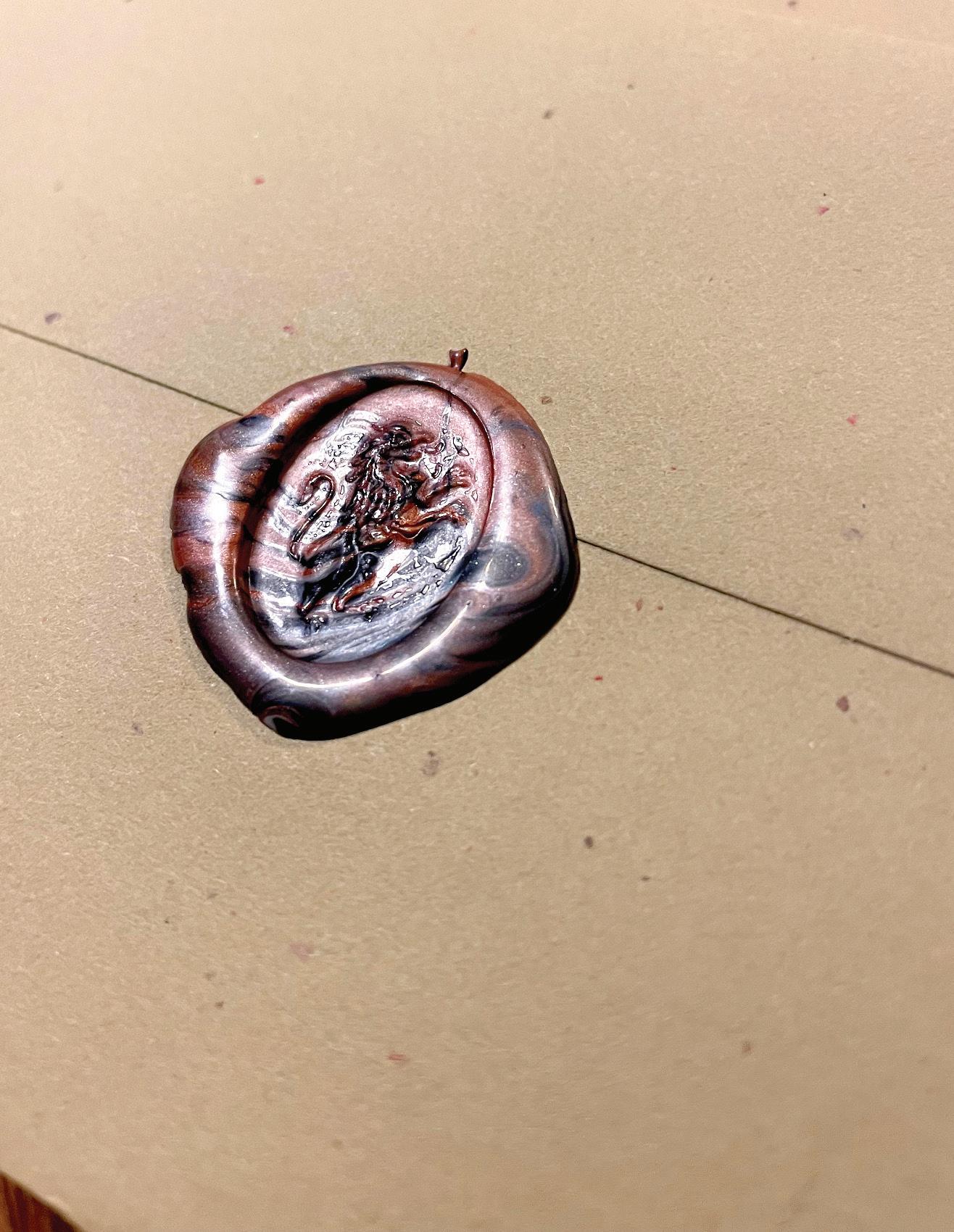
ies of wax pellets and sticks that can be used on their own, or blended to create swirling, shimmering combinations that perfectly complement your stationery and ink – or provide exciting contrasts.
Whether you use wax seals for security or art is up to you, but if the condition of the seal is an important part of your message’s design, understand that the fragile wax might become damaged in processing. I did a test while writing this story, mailing 10 letters bearing wax seals through the United States Postal Service using regular letter-rate postage. Half of them arrived intact; the others were partially destroyed, with either the design smashed flat, or part of the seal broken off altogether.
If you’re in the U.S., the USPS mandates that any “lumpy” mail or mail with buttons, clasps, or strings be mailed with the non machineable surcharge and hand cancelled at the post office. However, depending on the thickness of your seal (and how worried you are about it cracking), your letter might not necessarily fall into that category. Taking your mailpiece to the counter and asking the clerk is the best way to check if you’re concerned. And even if you can use a Forever stamp, you can also ask about hav-

ing your mailpiece hand canceled while you’re there. The process minimizes machine processing (without removing it completely), so your seal is less likely to be damaged on its way to its destination.
Another option that many people use is to encase the sealed envelope inside a slightly larger envelope for protection. Stickers which give the look of wax seals can also be a creative way to close a mailpiece with an adornment not likely to crumble. However, another way to look at it is that any weathering of your seal is just a reminder of the long journey of your mailpiece.
If you are intrigued by wax seals, and the history and creativity in this art technique, another way to explore it is by using the stamped wax for other crafts. You could use the seals on invitations you hand-deliver, or as part of gifts. You could use them as an adornment for place cards, or even for making a brown bag lunch special. The applications of these embellishments are as flexible as the material!
By John Hotchner
ISthere an incubator for stamp collecting? Yes, it’s called a stamp club. You may be familiar with the online stamp collecting groups that have proliferated since the advent of the internet, and perhaps as “digital natives” you’re drawn to the convenience of an online group.
But, in my opinion, there is nothing like an inperson stamp club, and almost 400 of them can be found all over the U.S., registered as American Philatelic Society (APS) Chapters. These chapters and their contact information can be found on the APS website (www.stamps.org). If you are a member, log in, then go to the “Community” tab and click on “Clubs.” Non-members can also access this resource, but you will need to create a a free account on the website.
An alternative is to Google “Stamp Clubs near ZI{ code ____” which will also bring up clubs that have websites or have somehow made it onto the internet.
Why bother, I hear you ask? What justifies going out to a place that may be miles away, to see people you don’t know, to talk about stamps that you may not even collect? Reasonable questions, and it does require us to make a leap of faith. But as one who did just that a long time ago, it was one of the best moves I ever made in our hobby. So, let me count the ways a club and its people can be a resource for you.
Just about everything in life is better when shared. Enjoying your hobby with like-minded folks is no exception. Even if they don’t collect precisely what you do, they have similar problems to overcome, and may well be able to share their experiences to your benefit. Beyond that benefit, we are all social beings, and the people of a club are all potential friends.
We all, I suspect, have a small frustration about the lack of interest in our philatelic accomplishments on the part of family members and even non-philatelic friends. The club is

a place where you can show off your material and see it get the appreciation it deserves.
A club where you are part of the group provides a friendly audience where you can practice and develop your public speaking and leadership skills. I believe we all have latent skills, which only need a non-threatening venue to strut their stuff with minimal stress.
Club members are usually willing, even eager, to share their hard-won knowledge about things like how to bid in commercial auctions, how to watermark, secrets of washing today’s difficult self-sticks from paper, and much, much more. Some clubs even have a formal mentoring program.
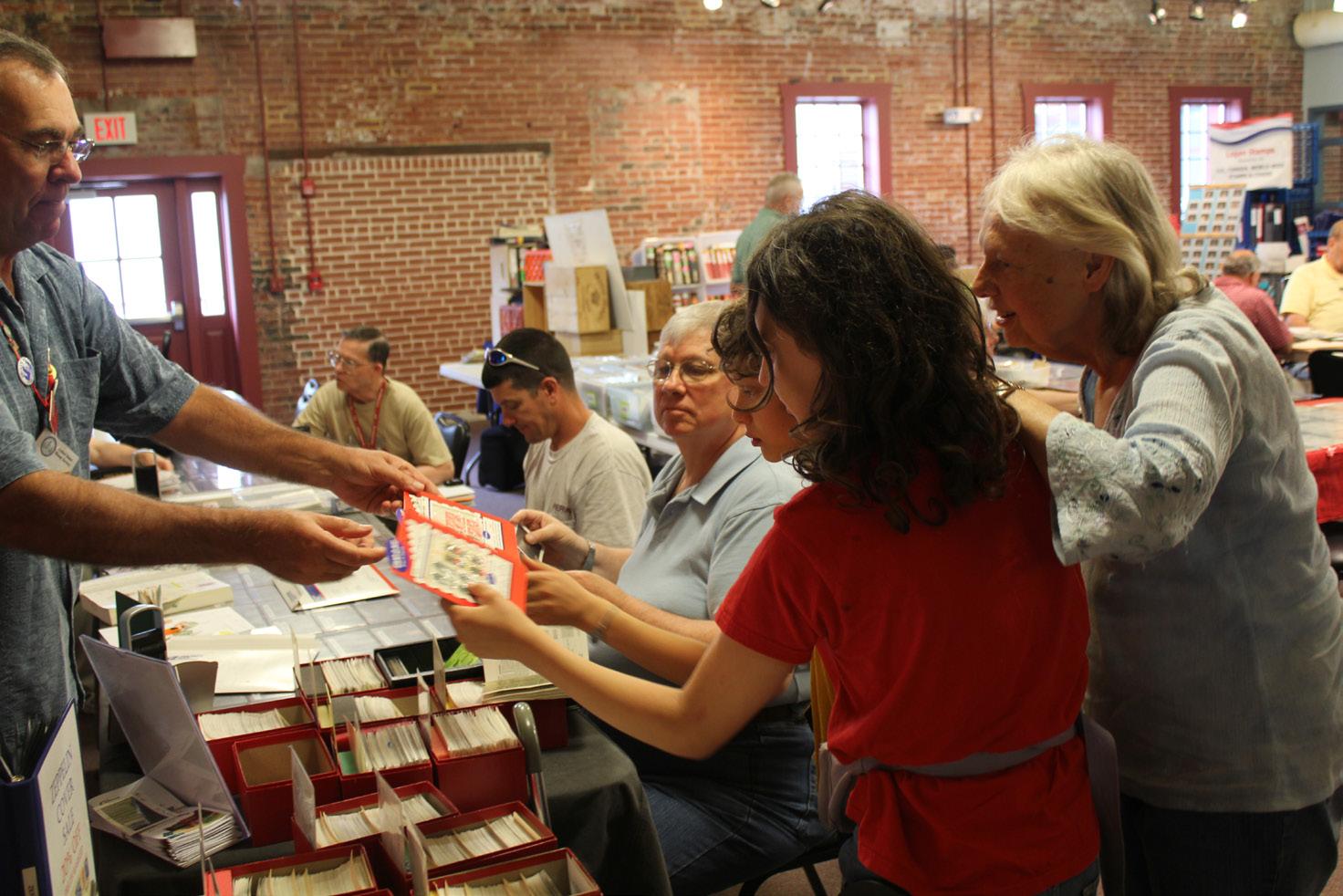
Are you a member of a local club? Tell us about your experience at StampEd@stamps.org or via social media at @stampedpub.
Commercial auctions and dealers are a great way to add to your collection, but buying from and trading with other collectors in a club setting – or apart from it once connections are made – can be less burdensome on your wallet.
Not only can you acquire new material for your collection through the club, but you can fund your acquisitions by using the club’s systems to trade or sell your unneeded material. These can include floor auctions, book auctions, trading books, and silent auctions.
Most clubs have speakers – either visiting or from among the membership – which give you the opportunity to see exceptional philatelic material, and to learn more about your collecting areas and others that you may not have known much about.
Most clubs keep members informed of philatelic events within driving distance, and some even sponsor day-visits to those that are a bit farther away than an hour’s drive.
Club members often share philatelic literature. This can take the form of owning a set of current catalogs that can be lent out to members between meetings, sharing national or specialty society periodicals, and tipping other members to internet sites of use or interest.
Clubs often have public events such as sponsored shows or bourses, first day ceremonies, or a club table at local celebrations, and this gives you an opportunity to participate in the life of your community.
With the demise of local stamp shops, it is a bit more difficult to get the supplies we need for our hobby: albums, supplements, hinges, tongs, etc. Joining a club gives you automatic access to the sources of supplies that members have established. Some clubs even qualify for bulk discounts by grouping members’ orders a couple of times a year.
Most clubs have some sort of newsletter – sometimes hard copy, but often these days, it's delivered via email or hosted on a website – from a one-page flyer to more elaborate periodicals that go beyond club activities to delving into diverse philatelic subjects. Here you can not only enjoy the publication, but also contribute to it through writing about your own interests, sharing news items and helpful hints, and being featured as a new member or member-of-themonth.
The point is sometimes made that clubs are a bit intimidating, especially to a newcomer to the hobby. And it can be true that members are at first not always as friendly as they will later become – simply because they are as reserved or shy as you may be. The key is to work through that ice-breaker stage and get involved. As the above indicates, it will be worth your time and effort as there is just no substitute for sharing our hobby with friends.
If you have questions I can help to answer, please contact me at jmhstamp@verizon.net.
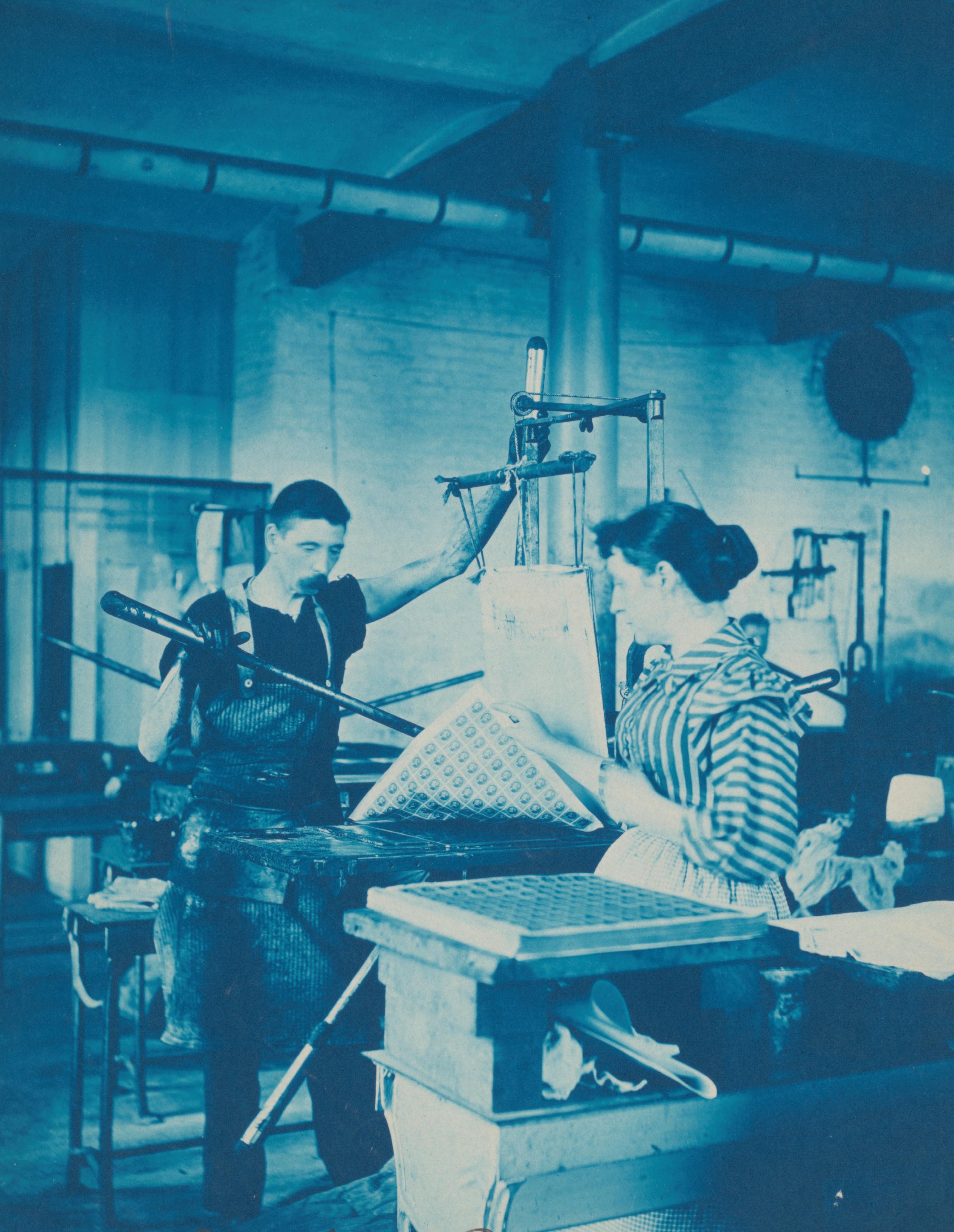



By Michael L. Wilson
The 1844 U.S. presidential election between Democrat James Polk and Whig Henry Clay was a nailbiter. Marked by controversies over slavery and the annexation of Texas, the election saw Polk winning by just 39,000 votes out of some 2.6 million cast.
There was one issue, however, that united Americans in 1844: The desire for “cheap postage.” It was incredibly expensive to send a letter in 1844 – or more accurately, to receive a letter, since recipients often paid the cost. Consider this anecdote from The Evening Post, a New York City newspaper, dated February 11, 1845:
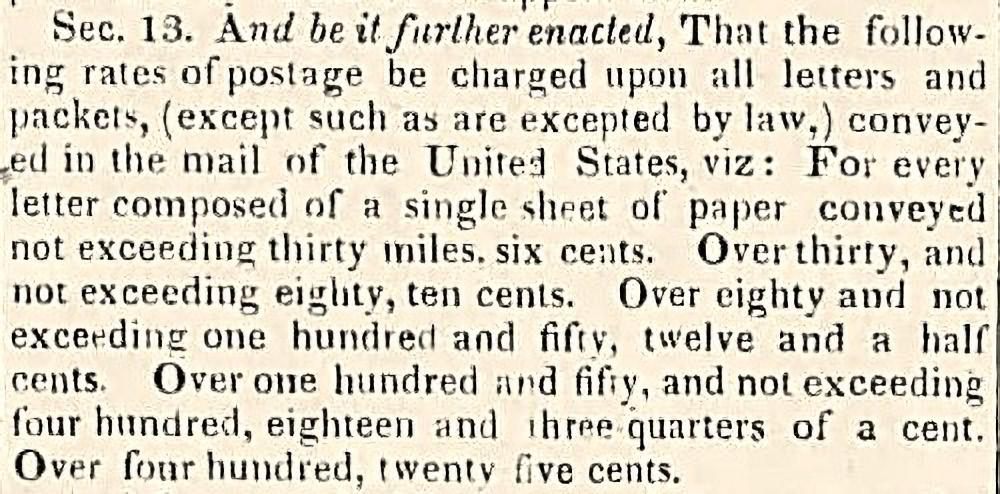
On March 9, 1825, the Daily National Journal of Washington, D.C. printed the Postal Act that Congress had approved earlier that month. The act set forth the postage rates that would remain in effect until 1845. With the exception of the rate for a single sheet traveling 150 to 400 miles, the rates were unchanged from 1816. These rates were multiplied by the number of pages sent, e.g., a two-page letter sent more than 400 miles would cost 50 cents.
A poor widow came weeping into a grocery store in Bleecker Street and was asked by a gentleman the cause of her distress. She replied that there was a letter in the Post Office from her son who had been absent eleven years, and the postage was twenty-five cents, and all the money she had in the world or could get was six cents, and the letter had been there some time and she had no means of getting it out. Many, very many poor women have been obliged to pawn their furniture or clothes to pay the postage of letters from their absent friends.
Another commentator in the July 25, 1843, Huron Reflector of Norwalk, Ohio provided this stunning comparison of postage relative to traveling or shipping goods across country:
The postage from Boston to New York is 18-3/4 cents, so that the man who has five letters to send, can pay for his own passage. It costs 18-3/4 cents to pay the postage from Troy to New York or Boston; but to send a barrel of flour from Troy to Boston, it costs but 25 cents, by rail-road, or twenty cents by a vessel, and a barrel of flour may be sent to New York with the same speed, and even in the same conveyance as the letter by mail.
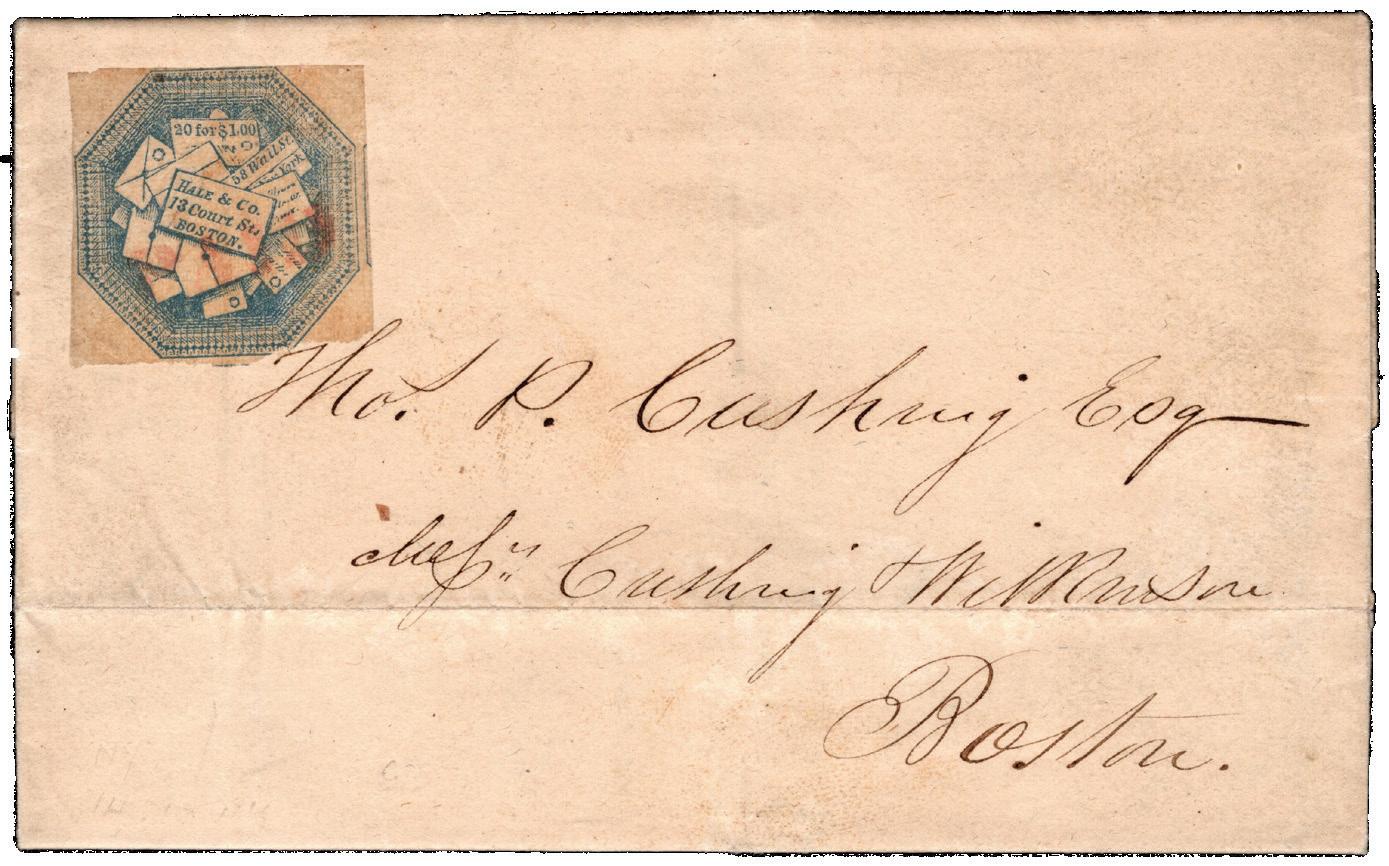

Private mail services started to appear in the 1830s. One of the most successful was Hale & Co., founded by James W. Hale in late 1843. As shown in this advertisement from the Brooklyn Evening Star of July 16, 1844, Hale would deliver a onepage letter far and wide for just 6-1/4 cents, a significant savings over the POD rates. That cost could be reduced to five cents by buying a sheet of 20 stamps for just $1. The folded letter sent from New York to Boston on October 14, 1844, is an example of a mail piece franked with a Hale & Co. stamp. Private mail services were put out of business by the Postal Act of 1845.
The U.S. Congress was inundated by many comparable stories. They heard about laborers who needed “half a day’s work to pay only for the transmission of one bit of paper” and families that journeyed from the East Coast to settle in “the prairies of the far west” and had to pay the equivalent of “half of bushel of wheat for every letter they receive.” Congress received numerous petitions from state legislatures and town meetings all with a singular message: “We must have cheap postage.”
The cheap postage advocates pointed to Great Britain, which had successfully reduced postage a single penny – equal to 2 cents in the United States – and introduced self-adhesive postage stamps for the prepayment of postage in 1840. In fact, the cheap postage movement in the United States was modeled after a similar effort in the 1830s in Great Britain.
There was opposition in Congress to lowering postage rates. Some were concerned that the Post Office Department (POD) would need a Treasury subsidy, but that was a weak argument. The POD was already suffering losses because the high rates were causing people, particularly on the East Coast, to skip the post office and find other ways to convey their letters through private carriers, like Hale & Company.
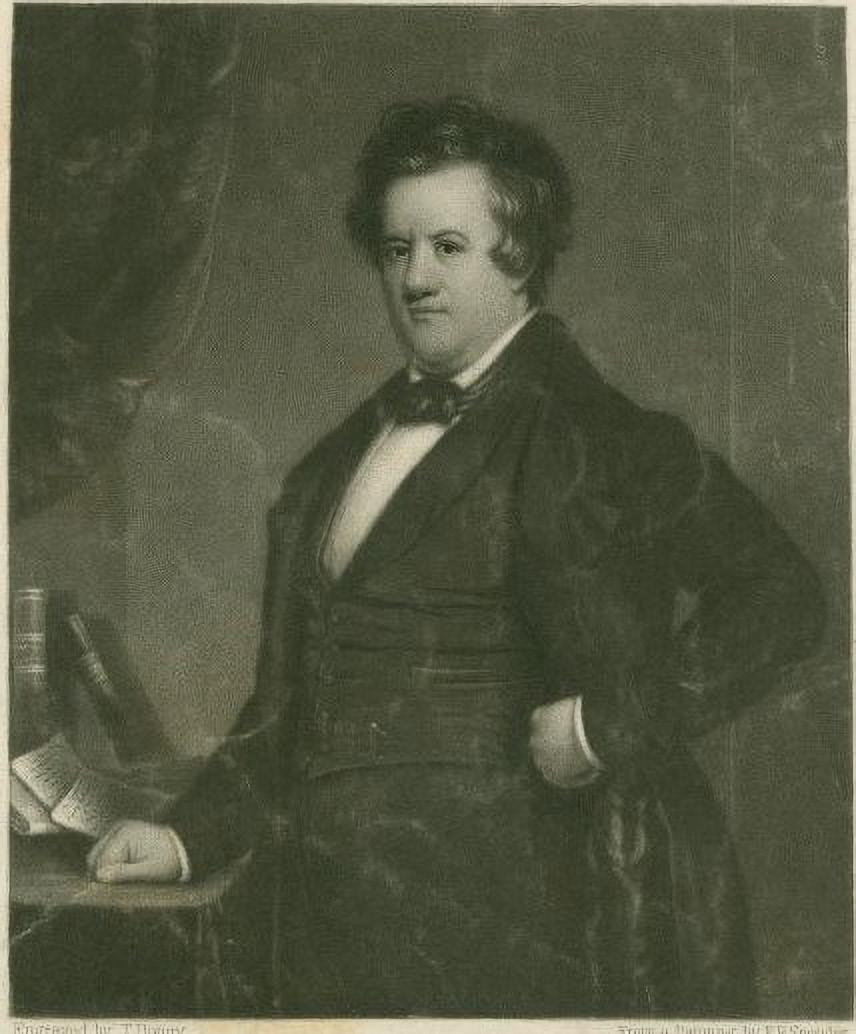
Another argument against lower postage rates: If postage was based on weight instead of the number of pages, it would encourage Americans to use thin French-made paper instead of good old American heavy-duty paper to write lengthy missives to their loved ones!
After much debate and competing proposals, Congress passed the Postal Act of 1845 by a wide margin. That act set a uniform rate of five cents for a half-ounce letter traveling 300 miles or less and 10 cents for any distance over 300 miles, effective July 1, 1845. Not only did this legislation cut postage rates roughly in half, but it simplified the rate structure by reducing the number of zones from five to two.
$0.02 in 1883 is equivalent to $0.62 today; just eleven cents less than the going first-class rate of $0.73. Considering that USPS now delivers to Alaska and Hawaii in addition to the continental 48, we think it's safe to say we still have cheap postage, no matter what the haters say.
Oddly, the final legislation did not authorize the POD to print postage stamps to prepay the new rates. Congress was certainly aware that other countries were doing so. Great Britain was the obvious example, and Brazil and the canton of Zurich in Switzerland issued their first stamps in 1843. Early drafts of the Postal Act of 1845 included a provision for the POD to issue stamps, but for reasons that are unclear, that was dropped in the final version.
Robert H. Morris, the postmaster of New York, however, saw an opportunity. He recognized that the lower and more uniform rates were tailored for the prepayment of postage via stamps. Morris also was aware that early closing hours of post offices constrained businesses and that postage stamps would ease their use of mail.
Morris wrote to Postmaster General (PMG) Cave Johnson for permission to issue stamps, which Johnson promptly granted. Morris contracted with Rawdon, Wright & Hatch, a wellregarded engraving firm known for its bank notes, to produce a stamp. With a supply in hand, Morris ran this ad in New York City newspapers on July 14, 1845:
The public is respectfully informed that the undersigned has caused to be prepared stamps for the prepayment of letters, made

An example of the New York Postmaster’s Provisional (Scott 9X1). This stamp (shown excerpted) is on a folded letter and has a certificate (#594552) from the Philatelic Foundation (PF) opining that “it is a genuine stamp” but with no opinion whether it originated on the cover, i.e. it may have been added after the fact. The stamp is canceled with a blue pen swish and has the ACM control initials in red.
for five cents each, which will be sold in parcels of five and upwards. To prevent counterfeits, they will be sold only at this office and the Branch Office. The public may therefore be assured that
any stamps which may be offered for sale at any place other than the Post Offices, are spurious, and will not be received as prepayment.
Morris was so worried about counterfeits and fraud that in addition to restricting the sale to just two locations, he also had most of the stamps initialed as another control. The most common set of initials seen is “ACM,” for Alonzo Castle Monson, the assistant postmaster in New York and Morris’s brother-in-law.
The stamp that Morris offered for sale is now known as the New York Postmaster’s Provisional. New Yorkers quickly adopted the stamp, and in less than two years, Morris issued just less than 144,000. Ten other local postmasters from other cities followed suit with their own stamp designs, but those were issued in much smaller numbers, and today, several are among the great rarities of philately, with matching prices. In contrast, used copies of the New York Postmaster’s Provisional off cover are relatively affordable and can be found for about $500 or less depending on condition.
There are also about 1,000 New York Postmaster’s Provisional covers known to exist. Most of the covers originated in New York, but there are also covers postmarked in other cities. The reason for that is that in 1846, PMG Johnson asked Morris to send a supply to postmasters in Albany, Boston, Philadelphia, and Washington, D.C. to

This cover with a New York Postmaster’s Provisional was postmarked in Boston on April 11, 1846. The stamp is “tied” to the cover with the postmark, which is a sign it was used to mail this item. This cover has a PF certificate (#18773) opining it is a “genuine use.” The U.S. Philatelic Classics Society keeps an online census of known postmaster provisional covers, and this is listed as number 20552. Of the 1,000 or so New York Postmaster’s Provisional covers, about two dozen originated in Boston.


The first two general issue stamps in the U.S. were released by the Post Office Department on July 1, 1847. The 5-cent depicting Benjamin Franklin (Scott 1b) paid the under 300-mile letter rate, while the 10-cent depicting George Washington (Scott 2) covered the over 300-mile rate. This 5-cent stamp has a certificate from the American Philatelic Expertizing Service (#236909) opining it is “genuine.” The 10-cent stamp is on a folded letter that the PF (#0321413) opined is a “genuine usage.”
evaluate the use of prepaid stamps on intercity mail.
The experiment was a success, opening the way for Johnson to ask Congress to authorize the Post Office to issue its own adhesive postage stamps. That authority came from the Postal Act of 1847. Once the first official POD stamps were issued on July 1, 1847 – also printed by Rawdon, Wright & Hatch – the New York Postmaster Provisionals were pulled from sale.
While the Postmaster’s Provisional era had ended, the “cheap postage” movement persevered. Contrary to the fears of some in Congress, the postal reforms of 1845 improved the Post Office Department's financial performance. Indeed, after reporting a loss in 1840, the POD reported a profit in 1845 and again in 1850.
With that news in hand, the “cheap postage” advocates redoubled their efforts, pushing Congress to reduce letter rates to a flat two cents for any distance traveled. Postage rates were reduced to three cents for a half ounce in 1851, and the distance differential was eliminated in 1863. The goal of a two-cent letter rate was finally achieved in 1883, almost 50 years after the “cheap postage” movement got its start.
The “cheap postage” movement was a grassroots endeavor; it did not have a national structure or leader. That may have been the source of its success, since, as Tip O’Neill, the former speaker of the U.S. House of Representatives, is credited with saying, “All politics is local.”
The “cheap postage” movement advocated for reducing the cost and complexity of postage rates, and that in turn paved the way for the issuance of postage stamps in the United States. So, does that mean we have the “cheap postage” movement to thank for this great hobby? I think it does!
An online search for “postmaster provisionals” comes up with several hits. Two articles on the Smithsonian National Postal Museum site are worth your time: “Postmasters' Provisionals (1845-1847)” (aps.buzz/AboutPostProv) and “Postmasters’ Provisional Stamps” (aps.buzz/ NPMPostProv).
If you are an APS member, a wonderful article by New York Postmaster’s Provisional expert Mark Schwartz can be found in the May 2024 issue of The American Philatelist.
The U.S. Philatelic Classics Society maintains a searchable database for known Postmasters’ Provisional covers: aps.buzz/PostProvCensus.
When buying more expensive stamps for your collection, consider getting an opinion from a stamp expertizing organization. Two of the better known are the American Philatelic Expertizing Service (stamps.org/services/stamp-authentication) and the Philatelic Foundation (www.philatelicfoundation.org).
Postal cards Ducks
Errors
Essays & Die Proofs
Graf Zeppelins
Modern Imperfs
Photo Essays
Possessions
Postal Counterfeits
Shanghais
Savings Stamps • Test Stamps
Washington-Franklins
Worldwide Artist Die Proofs
UN incl. Personalized Sheets Vatican City
Zeppelins
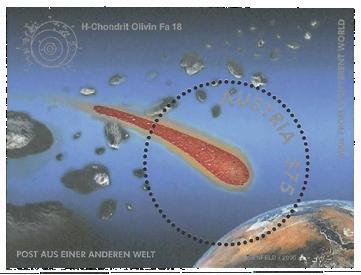
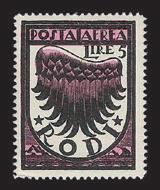



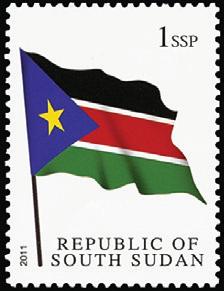
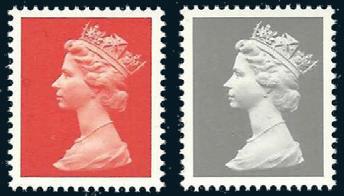
Peru RA13 Specimen Ovp’t






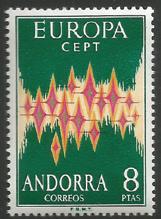

Russia 5833-36

Set of 5, normal color plus 4 different unissued colors. Am. Bank Note Co. Specimen Ovpt. Only 300 sets exist. (Ret. $100.00)
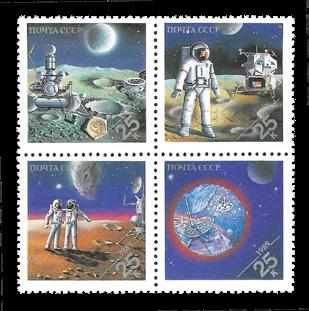

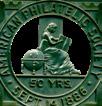




By Christina Tang-Bernas
What do Napoleon Bonaparte, letterpress printing, and leather have in common? They all led to a system of reading and writing for those with vision impairments, named after its creator, Louis Braille. Braille invented his eponymous system in 1824, marking this year as the bicentennial of this remarkable invention.
In 1815, Charles Barbier created a 12-dot phonetical system, called “night writing," which was meant to imply that this writing could be read in the dark. He was initially inspired by his experience in Napoleon’s army, where he saw fellow soldiers injured when trying to read messages at night. The lamps the soldiers lit gave away their position, and the enemy troops could pick them off from afar. Barbier realized “night writing” could also be helpful to those with eye injuries and other vision impairments.
Around the same time, Valentin Haüy, the founder of the first school for the blind, was using letterpress printing to emboss letters onto thick paper so that those without sight could discern the shapes of the letters with their fingertips. Louis Braille, who would become a student at Haüy’s institute in Paris, was inspired by both Barbier’s and Haüy’s work, as well as his own childhood spent watching his leatherworker father use an awl to pierce holes in leather. Even though an accident with an awl was what originally led to his own blindness, Braille would draw from his father’s work when developing the original 6-dot system of braille.
Sixty-three different patterns can be formed with the 6-dot braille matrix. Using specific rules of combining the Latin alphabet and other symbols together in various ways, a whole spectrum of numbers, words, and even font styles can be indicated, all of which can be felt by the braille reader passing their fingers along the lines of characters with just the right amount of pressure.
While there have been quite a few stamps depicting Louis Braille, people reading braille, and other related subjects over the years, the 1974 souvenir sheet issued by Brazil for the fifth World Assembly of the World Council for the Welfare of the Blind is considered to be the first postage stamp with embossed braille.
Since then, many innovative braille-embossed stamps have
been designed, with quite a few of them released for the celebration of Louis Braille’s birth bicentenary in 2009. Among these was the Lees Mee (Dutch for “read along”) stamps, designed by René Put for the TNT Post (now PostNL) in the Netherlands. Winning the Communication category of the Dutch Design Awards that same year, each stamp design contained three words spelled out entirely in braille characters, with only some of the letters of the word printed on
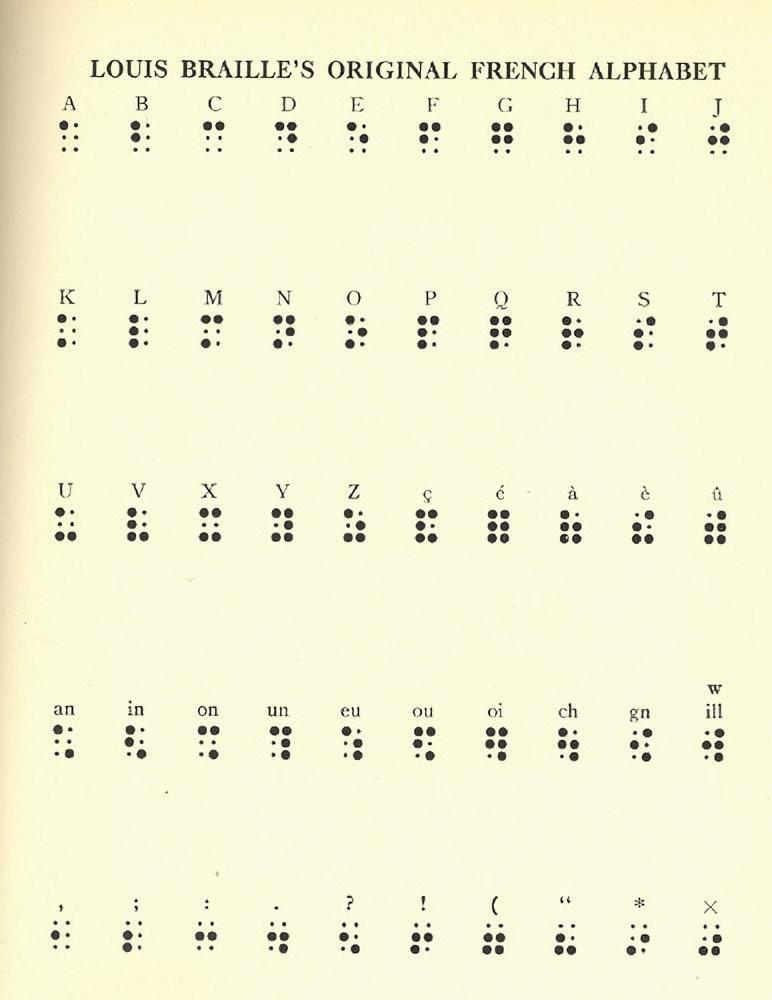
Original French braille alphabet developed by Louis Braille (SteveStrummer, CC0, via Wikimedia Commons).

A 1974 Brazil souvenir sheet. The stamp and margin are inscribed in braille with the name of the Assembly. Examples exist with the braille missing or duplicated in the margin.


top. Using the braille alphabet printed along the side of the sheet as a reference, the sighted user must engage with the braille characters to puzzle out the full word, with each message having meaning to both visually impaired and sighted people.
Through the design of these stamps, Put wanted to “better introduce sighted people to the world of blind and visually impaired people, in order to create awareness of this disability in general and at the same time to clarify the importance of braille in today’s information society.”
Put’s work is “always based on intensive research, both content and visually.” In the course of his research, he “wanted to know more about the relevance of the use of braille for [the] blind and partially sighted. What does this form of communication mean in their daily lives and how do they use it themselves?” After speaking with those who were blind, one person sent him a braille reglette tool with which one can write braille, and this became a starting point for the design.
Through the use of the reglette, Put realized that not only did he have to work within the confines of a postage stamp’s relatively small


size, but also that the braille text needed to be a fixed size, so that the braille text could be read with the fingertips. This meant that there could be up to 15 characters printed on a single postage stamp. Then, even if the design itself worked, the paper used for postage stamps is thinner than the paper usually used for embossing braille, and it had to be determined if blind people could even feel the dots at all. They could – and this stamp design is proof that constraints can actually lead to greater creativity.
In addition to the braille, Put wanted the printed letters to be accessible to those with other visual impairments. Per Put, since “people with visual handicaps often have enormous difficulty distinguishing colors,” it led him “to be very sparing with the use of color. Some letters have a hint of color besides the black, which adds refinement to the minimalistic design.”
Put was not the first to recognize accessibility can strengthen a project in other ways; in March of 1993, the UK’s Royal Mail issued the £10 Britannia stamp, which used the embossing of the value of the high-value stamp in braille as a security feature. Alongside granite paper with visible security fibers (thin silk fibers embedded in the paper), syncopated elliptical perforations (larger irregular perforations), optically variable metallic ink (ink that changes color depending on the viewing angle), multicolored microprinting (words printed so small as to require a magnifying glass to see), and phosphor tagging (coating that causes stamps to glow under shortwave UV light), the braille served to counteract fraud and counterfeiting.
The United States Postal Service (USPS) has also always been interested in new innovations in stamp design, even issuing a stamped envelope honoring blinded veterans on August 13, 1981, which included braille embossing.
However, the closest the USPS came to considering embossed braille on a postage stamp
was in 2007. Avery Dennison, a printing firm that printed many of the U.S. postage stamps at the time, created a pane of 20 embossed braille stamps as a prototype to demonstrate the firm’s capabilities to USPS program managers. The embossing was good, and the prototype included an interesting feature where each stamp was embossed with its position in the pane, with “Stamp 01” embossed on the top-left stamp, then “Stamp 02,” then so on until it reached “Stamp 20” on the bottom-right stamp. Not only would this help someone with vision impairment determine how many stamps were left to be used, but also, since each stamp was “unique” in the pane, it could interest collectors as well.
However, the USPS did not know who would be the main market for these kinds of first-class stamps. While collectors may have been interested, the very design feature that set the embossed braille stamps apart might make them difficult to collect and store. For unused stamps, the embossed dots could be flattened when pressed against other surfaces, such as if they were stored in the usual stockbooks or binders. Used stamps would also be difficult to collect in good condition, since letter-handling equipment would compress and flatten the raised dots.
Those with vision impairments who might be interested in using a braille stamp could already send many types of mail through the USPS for free using the same standards of FirstClass Mail (including reading matter in braille or 14-point-or-larger sight-saving type, sound reproductions, and devices used to write braille), so they would not need postage for most of their mailing needs. Due to these concerns and the higher cost of printing embossed braille stamps, the USPS decided not to proceed with developing the prototype further. Perhaps it will reconsider in the future if there is more interest.
That the USPS even considered braille stamps at all shows that the organization was


thinking about how people who have differences in ability may interact with mail and postage stamps. That’s the thought that went into Liechtenstein Post’s 2022 “Equality” stamps. Conceived by Christine Böhmwalder, the idea for the stamps was to draw attention to whether equality has truly reached everyone.
“Passing a law is probably the easier part,” Böhmwalder said in a recent email interview. “The real challenge is to anchor equality in society not just as a concept, but as a fundamental attitude that is taken for granted. Equality means more than practising tolerance, equality means flourishing diversity.”
The challenge for Liechtenstein Post lay in visualizing such a complex topic in a small space and
in an interesting, striking way, while ensuring that people without sight had access to the stamp. Designed by Isabella Gassner, with the bottom four dots embossed and the top two dots punched out using die-cut, “the equals sign (=) is graphically depicted once in braille and once in black print. The neon yellow background draws the viewer’s attention to the sign.”
These braille postage stamp designs draw attention to the fact that everyone has differing levels of ability and different ways of communicating, and may need different accommodations in the course of a lifetime. As Helen Keller said in a 1952 speech during the centennial celebrations of Louis Braille’s death in Paris, for those who are blind, “these raised letters are, under our fingers, precious seeds from which has grown our intellectual harvest … Like a magic wand, the six dots of Louis Braille have resulted in schools where embossed books, like vessels, can transport us to ports of education, libraries and all the means of expression that assure our independence.”
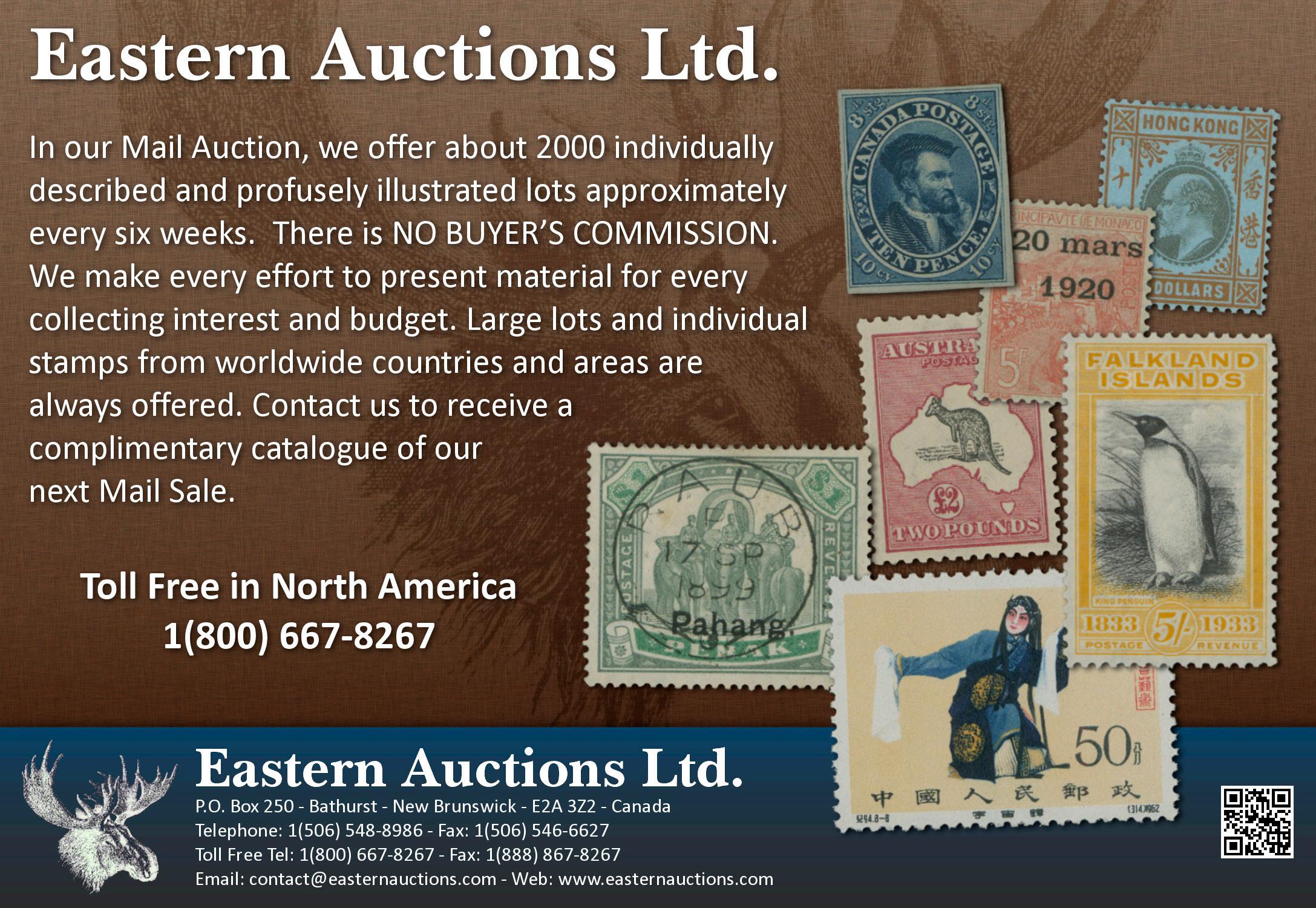
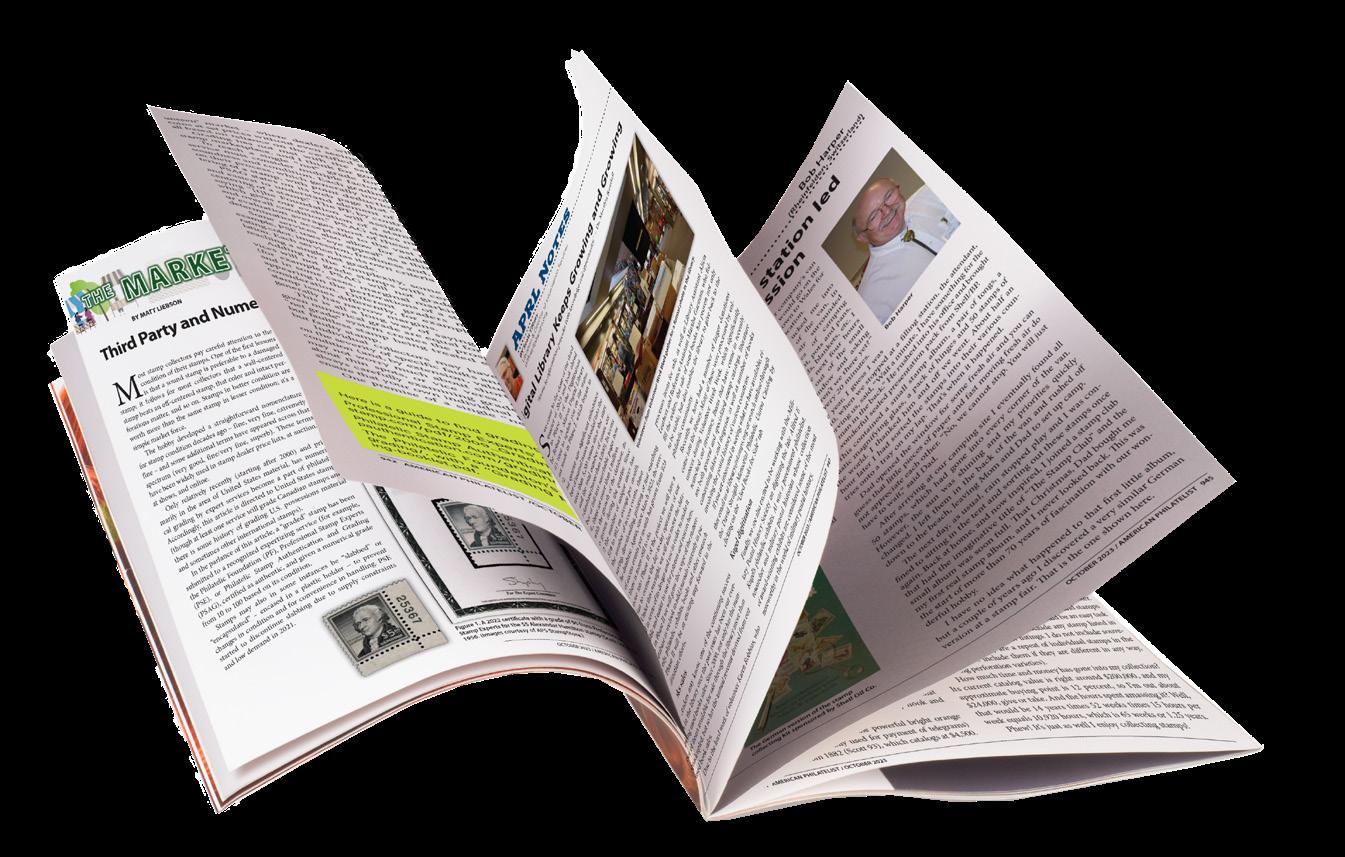

Antarctica was the last of the seven continents to be discovered. When Englishman Edward Bransfield confirmed in early 1820 the existence of previously unknown islands below South America in latitudes south of 60 degrees, he thought they might be part of the theorized, but never sighted, continent. However, he was not sure.
Nobody was – until 20 years later, when a squadron of United States exploratory ships under U.S. Navy Lieutenant Charles Wilkes sailed along what was presumed to be this landmass’s coast. In January 1840, Wilkes traveled for 1,500 miles, yet still could see more shoreline in the distance. That verified the existence of a continent at the very bottom of the world. Wilkes called it “Antarctica” (Figure 1).
There were never permanent human inhabitants of Antarctica, and there still are no fulltime human residents. The only people in Antarctica now are researchers, explorers, occasional adventurers, tourists, and those who support them. Over 20 countries regularly rotate researchers through their permanent and temporary bases on the continent, and a few others also come privately.
Despite this temporary way of living, four geopolitical entities issue postage stamps for any temporary visitors to their “claimed” parts of Antarctica, which can be used at post offices serving those entities.

A handful of nations have lodged claims (some overlapping) for what they considered to be “their” sections of Antarctica (Figure 2). An aspect of the claim-staking process involved establishment of postal facilities. These legitimate post offices can be

By Hal Vogel

established research stations. Courtesy of the University of Texas Libraries.

Figure 3. A New Zealand stamp overprinted “EDWARD VII / LAND” became the first Antarctic postage stamp.

found both at the Antarctic bases of claimants and at the facilities of nations which have never expressed any Antarctic territorial claims (e.g., the United States).
Today, the 1961 Antarctic Treaty suspends nations’ claims to the continent (and its nearby islands) for an indefinite period in the interests of scientific research. However, four of the countries with dormant territorial claims, New Zealand, Australia, Great Britain, and France, continue to issue valid territory-specific stamps through their Antarctic entities, the Ross Dependency, Australian Antarctic Territory, British Antarctic Territory (and separately, South Georgia and South Sandwich Islands) and French Southern and Antarctic Territories, respectively. In some cases, these regularly issued stamps are acceptable only for mail passing through the nation’s Antarctic territorial post offices. In the case of Australia, its “Antarctic” postage also is valid wherever Australian postage is permitted.
Antarctic entity stamps are interesting, attractive, current, affordable, and easily accessible. Antarctic stamp collections are readily capable of completion by the average philatelist.
The Ross Dependency is a segment of Antarctica facing New Zealand, containing the Ross Ice Shelf. Today, this is New Zealand’s “claimed” Antarctic region, but that has not always been the case. The Ross Dependency was named and formally established in 1923, when the United
Figure 4. New Zealand overprinted “VICTORIA / LAND” on one of its then current 1d stamps for use at the post office of the 1910-13 British Antarctic Expedition under Robert Falcon Scott. This block shows an unusually shifted version of the overprint.

Figure 5. Need for a 1/2d value to pay the fractional international rate from the 1910-13 British Antarctic Expedition post office prompted overprinting a half pence New Zealand stamp in 1911.

Kingdom ceded governance of the region to New Zealand.
In 1908, however, a stamp for the region had been issued bearing a different name: King Edward VII Land (Figure 3). It was followed a few years later by two additional issues reading Victoria Land (Figures 4 and 5). Because the United
The American Society of Polar Philatelists (ASPP) is an APS affiliate that specializes in the study, collection and display of polar (Arctic and Antarctic) stamps and covers. To join, contact P.O. Box 39, Exton, PA 19341-0039, or email alanwar@comcast.net.

Figure 7. The last stamps issued by the Ross Dependency before closing its Scott Base (Ross Dependency) Post Office in Antarctica was its 1982 “Life in the Antarctic” series, including the 20-cent value shown.

Figure 8. Ross Dependency issues resumed in 1994 with the 10-subject “Animals of Antarctica” set, including the 40-cent value shown.

Figure 9. An example from the 1944 first issue set of the South Shetlands with an overprint reading “SOUTH SHETLANDS / DEPENDENCY OF”. Other portions of the Falkland Islands Dependencies (South Orkneys, Graham Land, South Georgia) were similarly overprinted on this set of Falkland Islands stamps.
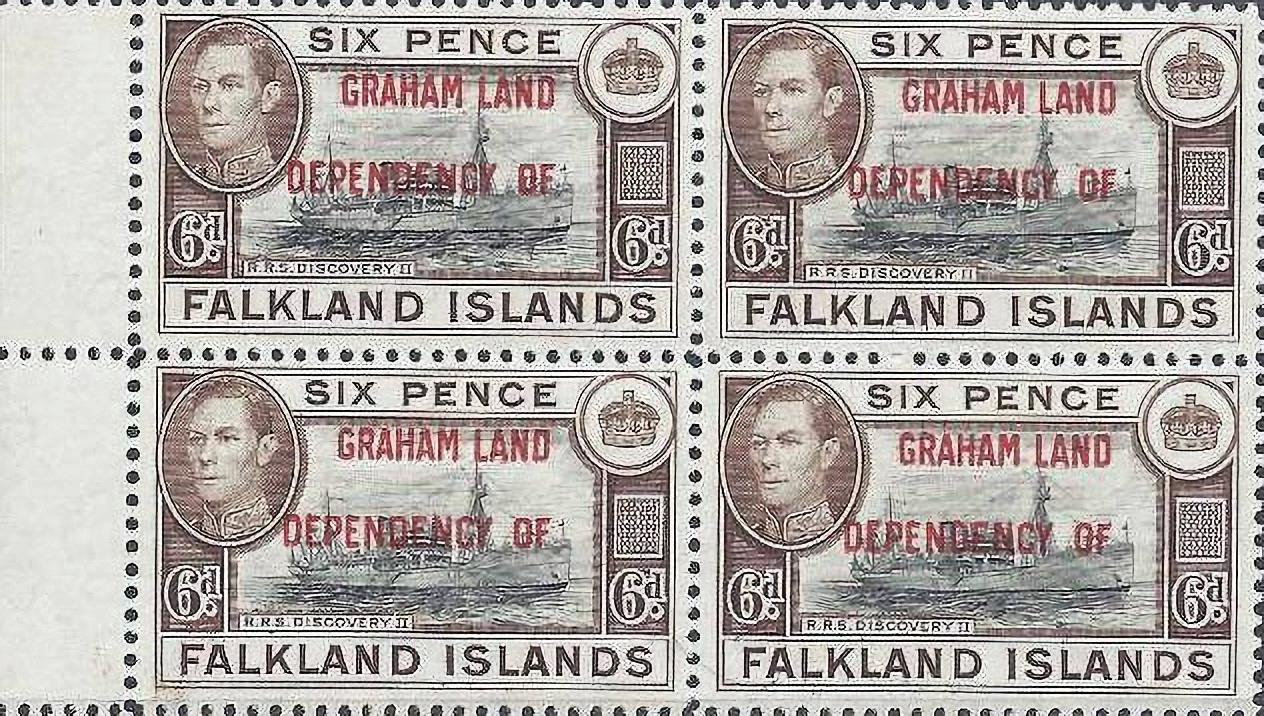
Kingdom based its claim on the area explored by Sir James Clark Ross in 1841 (including both Victoria Land and King Edward VII Land, which are part of the Ross Dependency today) these stamps are considered the first three Ross Dependency issues. All three stamps were issued by New Zealand (then a colony of Great Britain) as overprints on existing stamps, with the first for the use of the Shackleton expedition of 1907-09 and the second two for Sir Robert Falcon Scott’s tragic British Antarctic Expedition of 1910-13. The postal and governmental anomaly of the territory would become more clearly defined in 1957, when New Zealand issued the region’s first four official stamps, which read simply “Ross Dependency” (Figure 6).
Figure 10. Overprint for “Graham Land” is shown on the 6d value of the Falkland Islands set used for overprinting the first Falkland Island Dependencies stamps.
New stamps were issued periodically until the Ross Dependency’s post office at New Zealand’s Scott Base closed in 1987 (Figure 7). Occasional issues resumed in 1994 after significant worldwide demand (Figure 8). Mail from the Ross Dependency is processed by the Ross Dependency Agency, operated from a Christchurch post office in New Zealand.

Figure 11. The first (non-overprinted) issue of the Falkland Islands Dependencies is referred to as the “map issue” or “map stamps.” They were the “Dependencies’” own stamps (i.e., no overprinting of Falkland Islands stamps).
The British Antarctic Territory (BAT) and South Georgia and South Sandwich Islands are two separate Antarctic stamp-issuing entities that sprang from several former British stampissuing Antarctic systems. This continental chunk and group of offshore islands (i.e., South Georgia island and the archipelagos of South Shetlands, South Orkneys, and South Sandwich Islands) are on the side of Antarctica nearest to South America.
The evolution of this geopolitical structure (and its specific stamp issuing authorities) has a complex history, due to Great Britain’s various attempts to strengthen its sovereignty claims and better manage the territories.

Figure 12. The first set issued in 1963 for the new British Antarctic Territory.


Figure 13. The 1d stamp in the 16-stamp set of the 1963 first South Georgia issue showed the South Sandwich Islands.
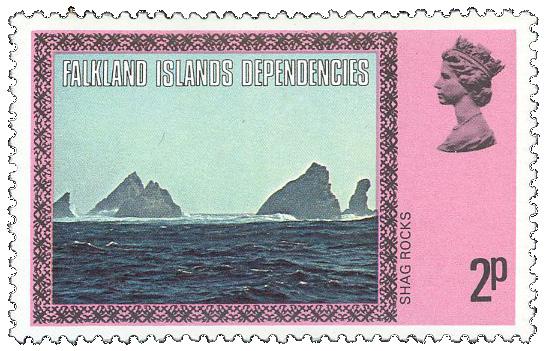
Figure 14. The renewed Falkland Islands Dependencies resumed issuing stamps with an extended set in 1980, including the 2-pence value shown.

Figure 15. The first set of South Georgia and South Sandwich Island stamps, issued in 1986, bore images of the British queen and the royal family. The 29-pence value is shown.

Figure 16. The Australian Antarctic Territory’s first issue in 1957 depicts the raising of the Australian flag during an exploratory landing on March 3, 1954, at Vestfold Hills.
The region’s first stamps were issued during World War II as part of Operation Tabarin, a secret British expedition that aimed to strengthen British claims to the Falkland Islands Dependencies. These issues were overprinted Falkland Islands stamps for “Graham Land” (located in the upper Antarctic Peninsula), South Shetlands (Figure 9), South Orkneys, and South Georgia. Several British bases were established in 1944-45 along the tip of the Antarctic Peninsula (Figure 10) and in the South Shetlands on Deception Island. At that time, no bases were established on the South Orkneys or South Georgia.
This Antarctic grouping was civilianized in 1946 as the Falkland Islands Dependencies and received its own postage stamps (Figure 11). In 1962, the BAT (encompassing the Antarctic Peninsula, South Orkney Islands, South Shetland Islands, and Graham Land) was spun off as its own entity and received its own postage in 1963 (Figure 12), leaving South Georgia and the Sandwich Islands as the only territories remaining in the Falkland Islands Dependencies.
However, from 1963 until 1979, South Georgia used stamps that read only “South Georgia” (Figure 13), before switching to Falkland Island Dependencies adhesives that also covered the South Sandwich Islands (Figure 14). In 1986, both South Georgia and the South Sandwich Islands began using stamps that read “South Georgia & South Sandwich Islands,” a style which is still used today (Figure 15).
Want to order new stamps issued from Antarctic stamp-issuing entities? Below, we’ve shared the best options for finding new issues.
Ross Dependency: Collectables.NZPOST.co.NZ
French Southern and Lands (mail only): Terres australes et antarctiques françaises BP400 97458 Saint-Pierre Cedex Reunion, France
British Antarctic Territory/Falkland Islands/ South Georgia and South Sandwich Islands: www.Falklandstamps.com
Australian Antarctic Territory: https://auspost.com.au/shop/collectables
The Australian Antarctic Territory consists of a large portion of East Antarctica, south and west of Australia and adjacent to Ross Dependency. Included in the region is the group of volcanic islands known as Heard Island and Macquarie Island.
Australia’s Antarctic postal activities precede the issuance of its territory’s first postage stamp, issued in 1957 (Figure 16). Additional issues followed periodically,
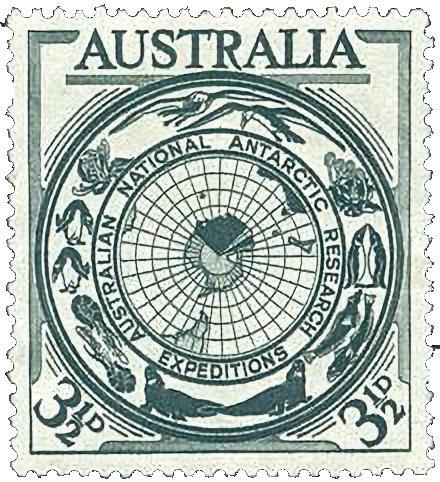
Figure 17. Some consider this stamp issued November 17, 1954, in Australia to be the Australian Antarctic Territory’s first stamp, but technically, it is an issue of Australia.

Figure 18. The 1961 commemorative stamp for the Australian Antarctic Territory featuring Douglas Mawson marks the 50th anniversary of the 1911-14 Australian Antarctic Expedition. StampEd
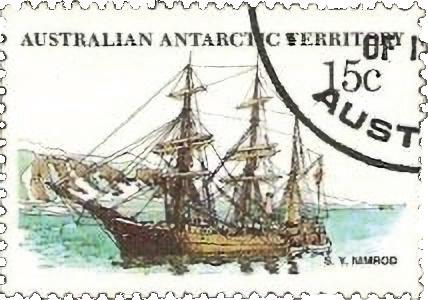
Figure 19. The mistakenly labeled “S.Y. Nimrod” stamp from the extended ships series of 1974 showed the wrong ship. Shown canceled at an Australian Antarctic Territory post office, it actually pictured the S.S. Morning.
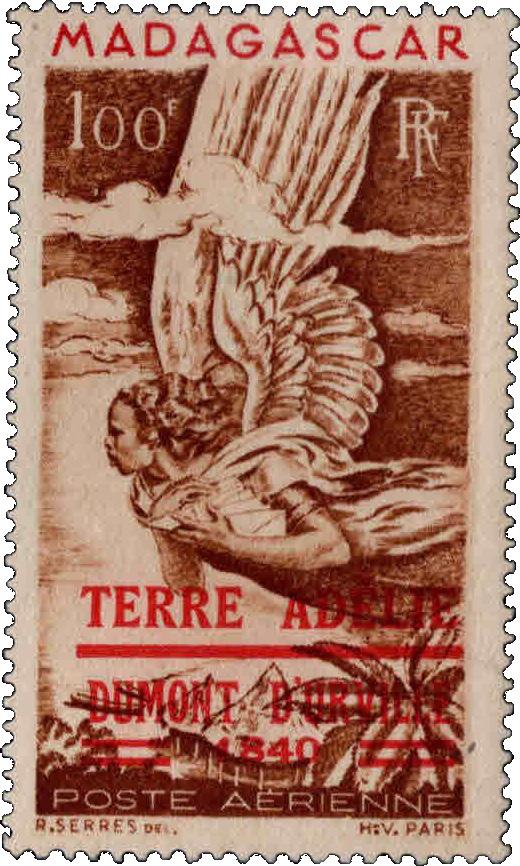
which are good for postage at post offices on both the Antarctic continent and Antarctic islands (Figure 17), as well as anywhere Australian postage is accepted (Figure 18).
French Southern and Antarctic Lands (Terres australes et antarctiques françaises)
This Antarctic claim includes a continental wedge (within Australian Antarctic Territory) called Adélie Land and four sets of south Indian Ocean islands (Kerguelen Islands, Crozet Islands, Saint Paul and Amsterdam Islands, and Scattered Islands). French Antarctic activity began in the 19th century, however, France did not issue its first Antarctic territories stamp until 1948. That first stamp was an overprint (“TERRE ADELIE / DUMONT D’URVILLE / 1840”) on a Madagascar airmail stamp (Figure 20).
France began issuing dedicated stamps for its southern territories when the administration of the French Southern and Antarctic Lands was established in 1955. The first stamp to bear the territory’s name (“TERRES AUSTRALES ET ANTARCTIQUES FRANÇAISES”), however, was, again, an overprinted Madagascar stamp (Figure 21). Since the 1950s, there have been mostly annual set emissions (Figure 22).
The Scattered Islands, four uninhabited islands surrounding Madagascar, were added to the French Southern and Antarctic Lands in 2007. As such, their postal system makes use of these French stamps (Figure 23).
Figure 20. A used copy of the first French Southern and Antarctic Lands stamp, which was overprinted on a Madagascar airmail stamp.

Figure 21. The first stamp issued by French Southern and Antarctic Lands after the entity was officially established in 1955 was another overprint of a different Madagascar stamp.
Four geopolitical entities issue postage stamps for any temporary visitors to their “claimed” parts of Antarctica, which can be used at post offices serving those entities.


Figure 22. In 1956, the French Southern and Antarctic Lands issued a set showing penguins and seals that was its first of many stamps that exclusively bore only the name of the territory.
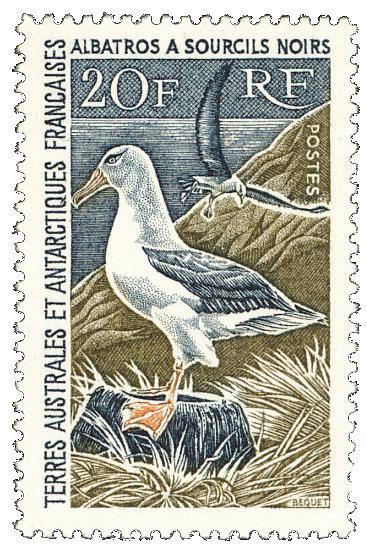
Figure 23. The 20-franc Albatross issue in a 1966-69 set is the most expensive stamp of French Southern and Antarctic Territories.
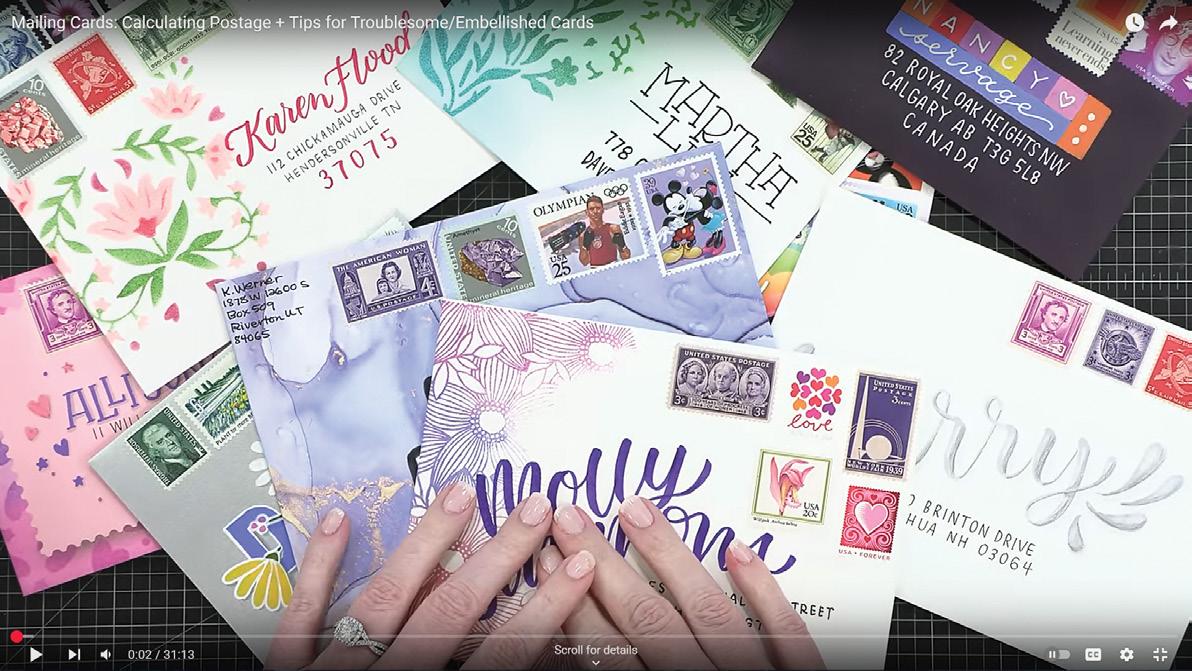
Kristina Werner (on Youtube as K Werner Design) is a mail artist who creates her own unique cards and envelopes. In this video, she explains how to calculate the correct postage for unusual cards.

See our Director of Expertizing Ken Martin talk about a new topic on stamps every week with the APS “Stamp of the Week” series.
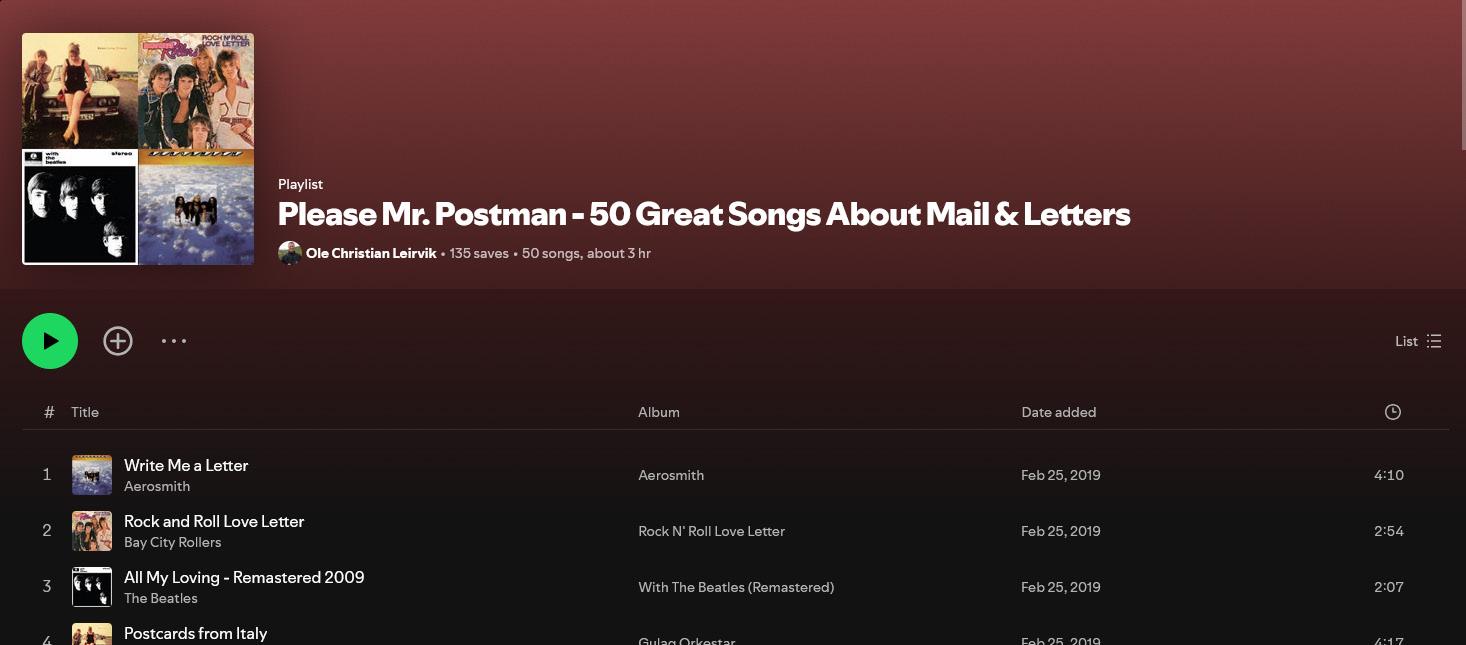
Spotify user Ole Christian Liervik created this 50-song playlist, “Please Mr. Postman – 50 Great Songs About Mail & Letters.” What songs are missing?
From Tumblr user lickmystamp, the 1988 U.S. issue “Cats.” The Cat Fanciers’ Association was called in to advise on this issue.
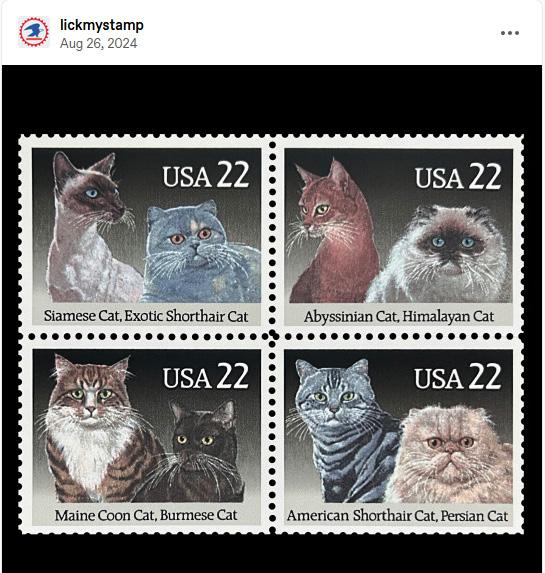

These 2024 Ukraine semi-postals raise money for animal shelters.

Have you heard of the deadly Beast of Gévaudan? The wolf-like creature(s) terrorized the French countryside in the 1760s. The perfect subject for this 2024 French stamp!
What do you collect? Send us a photo to share in StampEd! Tag @StampEdPub or email StampEd@stamps.org.
I’ve been collecting stamps on and off since I was in high school in the ‘60s. I have a nice collection of a couple thousand Art on Stamps in Lighthouse-type stock books, arranged by country.
I took my collection to an established local dealer and got an appraisal. I trust this dealer but the quote I got from them was very low, less than $150 for all those stamps and all those hours of collecting.
Here’s my “no bad question”: If I’m getting next to nothing for the collection, how about if I give them away? I’d rather give them to interested kids and new collectors. If I do this, either for a stamp club or a clearinghouse, is there a preferred way I should send them? Leave them in stock pages? By set in glassine envelopes?
Do you have other ideas about what I can do with them?
- How to Donate, from a reader
The American Philatelic Society generally promotes stamp collecting as a hobby to pursue for enjoyment, pleasure, relaxation, and intellectual stimulation. I understand that an appraisal of $150 for a couple thousand stamps may be disappointing, but the hours one spends collecting, sadly, rarely impacts the resale value.
We are not aware of any national clearinghouse for orphaned collections, but there are many other options. If you have a stamp club in your area (you can check at www.stamps. org/club-search, although a stamps.org web account is required), they may know of specific young collectors or local groups interested in receiving stamps. This could be Boy or Girl Scouts for a merit badge workshop, an afterschool program, a Youth Service Bureau, a local library, or even a children’s hospital.
There are many more national and regional options. The American Philatelic Society typically accepts donations of material which may be provided to school teachers with a lesson plan incorporating postage stamps or to a show youth area. Other groups, such as the Spellman Museum of Stamps and Postal History in the Boston area (spellmanmuseum.org) or the Postal History Foundation in Tucson, Arizona (postalhistoryfoundation.org), also gener-
ally welcome donations of philatelic material to support their programming. The American Topical Association (americantopical.org) might be another candidate, and Stamps for the Wounded (www.stampsforthewounded.org/), a service organization that accepts donations of philatelic materials to distribute to U.S. veterans, is a popular choice among philatelists retiring their collections or clearing out duplicates. Many of these groups are also IRS-recognized public charities which might allow for a charitable deduction on your taxes.
Consider also a friend of StampEd, Michael Lynn, of Michael’s Stamps, who assembles kits of stamps for new collectors and mails them out across the globe, absolutely free. Michael accepts donations of stamps and covers from fellow philatelists, and can be reached via email at usstamps@mac.com.
As for how to package your materials to send off, the requirements will vary by organization. Stock pages and glassines are common solutions, but some groups will accept donations in less organized forms (boxes of loose stamps, for example), or will have specific packing instructions for you. We recommend reaching out to the organization if their donation and packing criteria are not listed on their website.
Gifting all or part of a stamp collection no longer of interest is a great way to introduce others to the hobby and hopefully extend the joy of the hobby to new collectors.
- Ken Martin
Iwas entrusted with my family’s stamp collection and would like to improve how it is kept. What recommendations do you have for stamp storage that are both convenient to access the stamps and store the stamps safely?
Thanks for the question! This is a broad answer, in hopes that an aspect will cover your situation and the rest will be helpful to other collectors.
What constitutes proper stamp storage is a highly individualized topic - it’s mostly about starting with proper paper storage and working from there to figure out what’s the best solution for you, your collection, and your space.
Our top tip is to make sure your stamps aren’t being kept in a humid or overly hot or cold area - damp can bring mold or disturb the gum on the back of the stamp (or even make your stamps stick together), and extreme variations in temperature can compromise the stamp as well. Many a stamp collection has been lost to basement or garage storage - which reminds me, you’ll need to be aware of the pest situation wherever you choose to store it, because they do love to nibble on old paper.
If the stamps in your collection are largely loose in boxes, the next step up would be to get one or more stockbooks to store the stamps in. Stockbooks let you organize your stamps without having to mess around with mounts or hinges (more on that in a second). They also keep your stamps flat and come with leaves of either some kind of plastic or a sort of waxed paper material between each page to keep your stamps from interacting with each other chemically.
If you have a stamp store in your area, you can almost certainly purchase stockbooks from them, or you can buy directly online from the various brands (just search for stamp stockbooks). You can also often find new or lightly used stockbooks on sites like eBay - just be sure to check the price against going rates for new stockbooks so you’re not overpaying.
Stockbooks store a lot of stamps for their footprint, and most fit comfortably on a standard bookshelf. The major downside in my experience is that depending on the material the little sleeves are made of, your stamps might slip around a bit.
If you want to kick it up a notch organizationally, you’ll want to invest in a stamp album. Albums are typically organized by subject or geographically (for example, you might have an album featuring U.S. stamps from 1900 to 1950) and have spaces reserved for each stamp. You can then adhere the stamps using hinges or mounts.
These days, most albums are in binder format so you can add additional pages as needed, but sometimes you can get an actual bound book. You can purchase album pages from stamp stores or online providers, but some are available for free to download and print out (including a lot from our parent organization, the American Philatelic Society). You can also make your own pages to fit your collection, in a word processor or a graphic design program (or with pencils and pens, the old-fashioned way!).

Just be aware that if you’re making them for anyone but yourself, stamp copyright is real and complicated.
There are also a variety of short term solutions for a small collections or portions of collections, including glassines (which are envelopes made out of that waxy paper), regular envelopes (but make sure the paper’s acid-free/archival quality if the stamps will be in there for any length of time, and regardless it wouldn’t be my top recommendation), and stock pages (which are individual stockbook pages with sleeves that you can put in a binder or use to send stamps through the mail). I’ve also seen people use cigar boxes and match boxes.
If you’d like more in-depth information about stamp storage and preservation, be sure to check out the APS website.
- Nora Bryson
Consider us your stamp collecting “Dear Abby.” Just write in to us at StampEd@stamps. org, subject line “No Bad Questions.” We’ll publish your question anonymously and respond as best as we can!
By Susanna Mills
Album pages are one of the most popular ways for people to organize their collections. Typically, an album page will be printed on high quality acid-free paper, with spaces for individual stamps. Generally, they are organized by stamp-issuing entity, date, and (sometimes) by catalog number. You can find worldwide album sets by year, or in a range of years; individual country sets; and sometimes, topical albums.
A lot of collectors start out by using commercial album pages, such as those made by Scott, HE Harris, Minkus, and Lighthouse. These and other companies sell high-quality albums, which include images of the stamps and limited additional information.
However, unless you’re sticking to the very basics, the commercial album pages will often just not be good enough. The designated space may not be big enough, or you may have multiples of stamps, variations or errors, booklets or souvenir sheets, pairs or plateblocks. Or, you may have a collection of covers or postmarks, or a collection of topical stamps.
If this is the case for you, but you still want to have a well-organized collection, you may decide to design your own custom album pages. This can be an immense project; in fact, I’m thinking of creating my own album pages for my Discworld cinderella stamp collection, which, once complete (if it ever is), would have more than 1,500 stamps, not to mention covers and ephemera. Once I started thinking about it, the idea was daunting – many of my copies have selvage with marginal markings, meaning that the shapes of individual stamps are nonstandard. Plus, there are many known varieties, but
The American Philatelic Society is proud to publish StampEd, a magazine for the new generation of stamp collectors.
The American Philatelic Society is the largest non-profit organization for stamp collectors in the world. Founded in 1886, the APS serves collectors, educators, postal historians, and the general public by providing a wide variety of programs and services.
realistically I will not be able to add all of them to my collection.
I highly recommend reading a blog post, “A Guide to Custom Album Pages,” written by Jim Griffith in the early 2000s, which spelled out all of the things someone should consider when embarking on the journey of making their own album pages. It’s an old post, but still has great information.
The American Philatelic Society also makes some of its own album pages, available for free for anyone to access at stamps.org/stampalbums. Most are U.S. year sets, while others are albums of stamps celebrating specific historical anniversaries and milestones for individual states. There are also a handful of topical albums (none are meant to be comprehensive).
Our content team (particularly Nora Bryson) helped create the last few U.S. year albums, and updated the Black Heritage Series album in February 2025. Our tool of choice was the webbased graphic design platform, Canva, which can be used as a free platform for basic design work. Feel free to check out our albums, and let us know if you were inspired to create your own!

catalog of sets, singles, souvenir sheets and more.
DiScovER 5,000 or more items to choose from each week.
FinD every price right from the least expensive 25 cent stamp to the most expensive available.
ExpERiEncE the ease of paying by cash, check, Master Card, Visa or Discover.
Enjoy knowing your order will be shipped the next business day. appREciaTE never having to worry about having a minimum order.
send us a postcard, note or e-mail to start your Trial subscription* today. No obligation of course. *Trial subscription duration: 4 weeks mail, 12 weeks email. Non-u s. addresses eligible for email only.




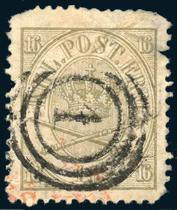

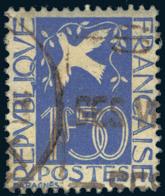
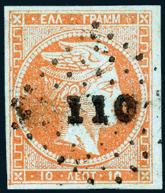







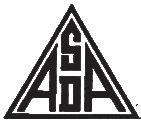
Editor-in-Chief, Susanna Mills • Senior Editor, Jeff Stage Marketing Manager, Nora Bryson • Graphic Communications Specialist, Chad Cowder • Publisher, American Philatelic Society

A depiction of the world as imagined by Sir Terry Pratchett. Painted by Chad Cowder.